The last IJN battleships: IJN Yamato, like Bismarck, is the subject of a post-war myth. Mysterious, because classified as highly secretive, it was known only by name by the US secret service in 1941 when she entered service. This ship and her sister, still fascinates the world today, justified an underwater expedition, movies (such as “The men of Yamato” in 2005), as well as a quantity of books, comics, series and animes. A massive 1/10 model was made of her, now in The Battleship Yamato Museum, close to where she was built in Kure. She definitely became an icon in today’s Japanese culture. But what was the ship behind the myth. Was the concept behind her construction valid at the time ?

Yamato completed in Kure in September 1941.
The IJN Yamato herself was the leading vessel in a whole serie of four “new generation” fast battleships. It was part of a massive naval rearmament plan begun in 1937. This was the first battleship class since 1918, when the last IJN battleships of the Amagi class were started. The long vacancy imposed by the naval treaty was used to elaborate many designs, while the main caliber gun already had been worked out for 1920s designs.
IJN Yamato (the former name of Japan) was literally designed around her record-breaking main artillery, of 18-inch (457mm) guns, dwarfing the average caliber of the time, comprised by treaty between 330 and 406mm (15-in – 16-in). This caliber had been banned by the Washington Treaty in 1922 anxious to avoid escalation, but the Japanese retired from the treaty in 1935. Aside these massive main guns, the ship was generously dotted with secondary guns, dual purpose and AA artillery. Protection was not forgotten also and featured probably the best combination possible to fend-off all shell ranges, with the largest armor thickness ever seen on a ship, never equalled or surpassed. Sailors that took service on this ships were rightfully proud of this “unsinkable battleship”, the very symbol of Japan’s trust into its navy. The Yamato class was thought for total naval supremacy, compensating numbers by quality. But the active life of both battleships showed a lack-luster record, to the point the lead ship was even called “Hotel yamato” stuck in port, due to the lack of fuel. When released for a suicide mission in 1944, this was to meet a maelstrom of naval aviation. Showing for good to all, that the time of big-gun battleships was at its end.
Genesis of the Yamato: Interwar designs
A part of this process could be found here
This development mostly came back to 1919 and the N°13 class, planned to be laid down in 1924, but cut short by the Washington treaty. They would have been practical ancestors for the Yamato, with their main battery of four twin turrets with 460 mm guns (18 in), 274.4 m (259.1 wl) long for 30,8 m wide and 9,8 m of draft fully loaded for 52-55,000 tonnes fully loaded, propelled by four shafts Gihon/Gijutsu-Hombu geared turbines fed by 22 Kampon boilers for 150,000 hp and 30 knots. They were still transitional battlecruiser/fast battleships, with a relatively “light” armor, the Belt 330 mm string at best, but sloped 15° and 120 mm armored deck. Shorter, beamier, twice as much armoured and 20,000 tonnes heavier, the Yamato shows the long development made in between.
In between theoretical researches and reconstruction of the Kongo, Fuso, Ise and Nagato class, which allowed to test new underwater protection scheme, deck armopur layered scheme, new AA arrangements, new bridge designs and onboard aviation management, the 1920-1930s left engineers plenty of matter to work with. But the late development leading to the Yamato class could be summarized as the 140 Design.
Design 140: The genesis
In 1928-29 already, the Washington Treaty was set to expire soon. The head of the design department and technical adviser produced sketches for a future battleship and a high level Technical conference in 1929 pitted competing designs, allowed to show the same basic principles, with only variations in armament and arrangements, supposed to cover many options. They also showed different and competing school of thoughts, but still all capped to the 35.000 tons displacement limit. It was the one sent for the planned Kongo/Fuso class replacement program. The London Treaty eventually came out in 1930 and extended the ‘battleship holiday’ for 5 more years. Superstar designer Hiraga designed an extremely concentrated citadel, with very heavy sloped thick plates with cross sections clearly similar to those later adopted for the Yamato. These plates were up to 15 inches (380mm) for the belt for example. However the unprotected parts were also very long and at the bow and stern, with an old-fashioned casemate artillery and turrets.
One interesting design was a 30.000t version three triple 356cm guns, which contains many ideas later taken onboard for the A140 design. Called Variant E in 1929, it mixed indeed a secondary battery with casemate and turret guns, and its central citadel was only 1/3 of the total length of the ship.
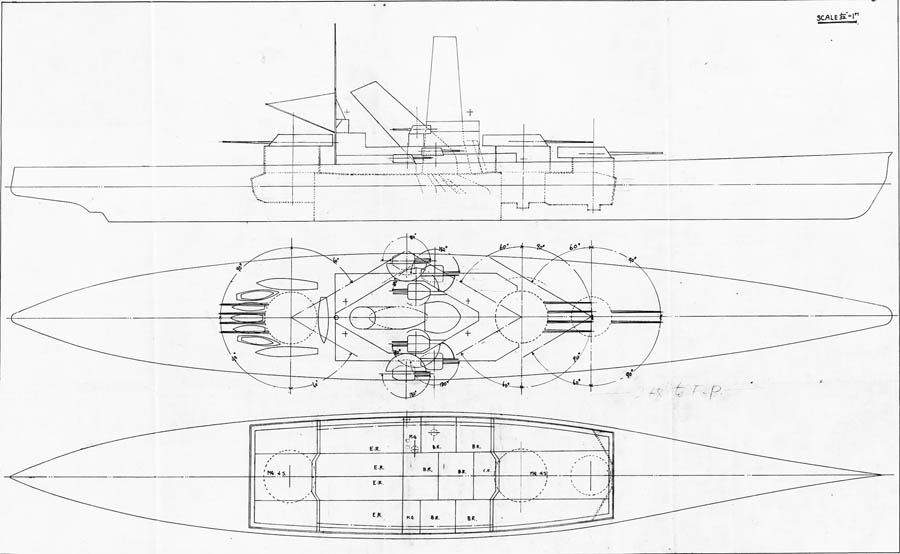
-35,000 tonnes design, 3 turrets, 10 guns
This design has been saved as part of hiraga’s own archives. Called Design “X” it might have been drafted in the sumer of 1929 and is most unusual as showing 10 guns, in two triple and two twin turrets. Basically the Japanese versions of the King Georges V. However contrary to the latter, ‘B’ quad turret was superfiring, not at deck level cntrary to the light ‘A’ twin one.
Recent information about the main and secondary battery shows two calibers, either the trusted 41cm/50 guns but also… dual purpose artillery. 14cm/55 formed the secondary artillery and the casemate had tailored cradles to elevate as far as 75° for DP mode. The final alternative was the classic 15cm/45.
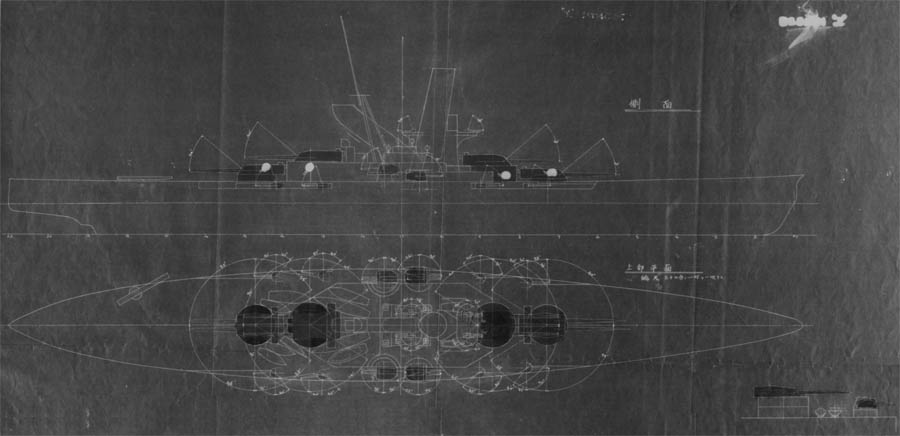
Hiraga design X, modified version in 1930. This is an alternative model with two triple and two twin turrets. Like the others, the citadel is very compact.
Design X 62,000 tonnes
In September 1929, another design was sketched up by Hiraga, in which he proposed an “unrestricted” alternative with nine 45 cm guns as main armament in a Nelson-style layout. The main armament was concentrated on the forward deck, while the secondary armament was placed aft, with three triple 20 cm (8-in), an unusually heavy secondary caliber, aft of the superstructure. Third, high-angle DP twin guns, six 127 mm (5-in) placed high up close to the main bridge. Protection basically was the same as previous designs, notably around the magazines, turrets and conning tower. It has been staged in ordere to cope with 450 mm (18-in) shells at range of 20 to 30kms and from 25 kms abover the machinery armour. Propulsion counted on diesel and turbines for additional range, and about 200.000 SHP for 32 knots. The ships were mammoth’size, 290 m on the waterline, probably 300 overall, 37 m wide for 10.2m draught. Main turrets had mounted roof catapults and using the same aircraft elevator shown on IJN Fuso. This sketch is probably the most ancient known on the lineage that went up to the A-140 series, and this is 1929.
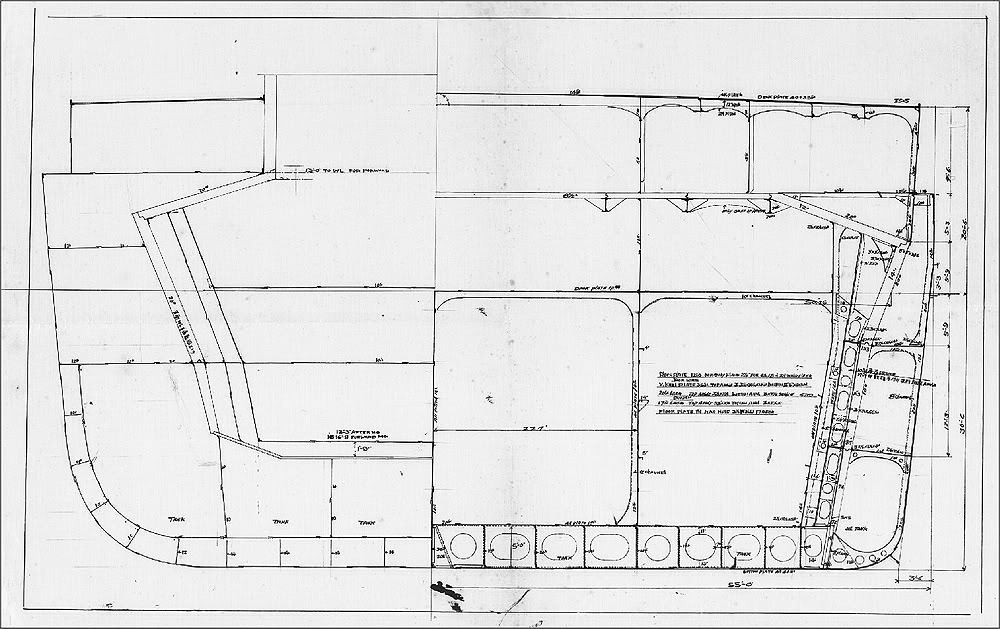
Design X armour scheme cross section
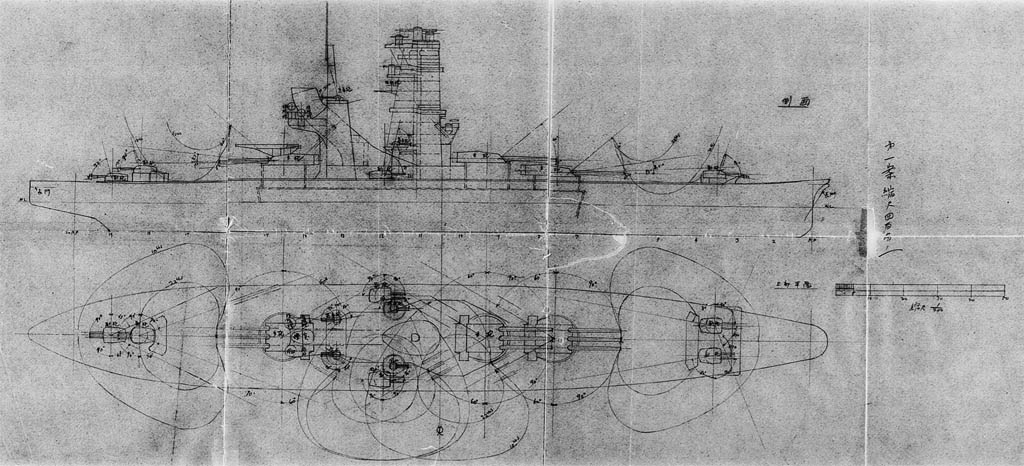
Fujimoto alternative design. An aternative treaty compliant design, which is short, with again a very concentrated citadel. It combined a mast-stack combination, very large adnd tall bridge structure, and undulating sheer deck line forward and aft, flush deck configuration saving weigh. The secondary battery is placed in a singular maneer, with two twin forward turrets in tandem and two superfiring aft, two broadside, the latter being the only ones protected by the citadel. They used the same HA mountings used on Hiraga designs. Other Fujimoto designs appear to be based on verbal description, and are reconstructed. Primary sources are nonexistant.
Fujimoto’s FY1936 naval plan
Kikuo Fujimoto however worked out on a very ambitious naval plan starting from 1936, and up to 1950, the Japanese equivalent of German Z-Plan. By then Japan has been dissatisfied with both the Washington and London treaties. Aware of the advantage of the United States, this plan reaffirmed the Japanese focus on quality over quantity. It was really tailored for a confrontation with the United States Navy, which had placed an artificial limit to ots battleships size based on the beam, compatible with the locks of the Panama Canal. With 33m and the necessary provision of ASW layered protection, the IJN worked on five design studies to estimate how far a USN battleship could go. And these predicted the Iowa class rather accurately. Based on these studies, engineers devised solution to beat these future US battleships in a duel. Gun caliber estimated for the US staied at 16 inches and protection tailored for the Japanese 41 cm caliber, so the Japanese soon settled on the 18 inches caliber.
Fujimoto however expected the US to also jump to 18 inches as well around 1941 in response for ships launched in 1938-39, so another provision was made for the designs: 18 inches turret barbettes strong and wide enough to accomodate a twin 20 inches turret as well (508 mm). It was indeed planned to rearm existing battleships in 1941-46 to this new standard. So the four “Super Yamato” fitted woth eight 20-in guns were planned to be started just at the same time the Yamato class. The plan counted on a grand total of eleven 20 in battleships for 1951, ensuring domination for ten years. At the same time both the Mogami and Tone classes (also from Fujimoto) used the same concept with with 6 inches gun turrets to be replaced by 8 inches turrets on completion. About these 20 inches guns, navweaps says the following:
45 caliber Type 98 51 cm Gun:
These guns were planned for last two ships of the 1942 Naval Construction program, the 90,000 tons “super yamato”, armed with eight or nine 51 cm (20.1 inches) guns. The final design was down scaled to three twin turrets (6 guns), but never ordered. All their plans were destroyed and nothing survived to have a cle of their apperance or details.
Sketchy sources affirmed that two guns and a mount were ordered from Kure Navy Yard in June 1941. Construction was halted when the first gun was completed with its breech mounted, the second only had its 4A barrel completed, mount and fittings left unassembled. No further work was done, but construction was just an up-scaled version of the 46 cm (18.1 inches) of the Yamato class. Asbury type breech, and Welin breech block and denominated A Gun (Kô Hô) Type and probably called Type 98 (1938) or Type 94. Based on what survived of the 1938 design, each gun weighted an amazing 223.4 tons alone, complete with breech mechanism, measured 927.6 in (23.56 meters) overall. Their planned rate of fire would have been around 1.25 rounds per minute, and the shell had bagged charges, would have weighted, for the APC 4,190 to 4,409 lbs. (1,900 to 2,000 kg) and for the HE 4,097 lbs. (1,858 kg). The turrets were of the Design A-150 weighting 2,736 tons (2,780 mt), so as much as a destroyer. They had a 45° elevation rate, so about 10° per second could train +120/-120°at around 2°/second. So these turrets were about the same as the Yamato class.
Design work for the 460 mm and 510 mm guns and their mountings dated back from April 1934 and at least four 460 mm variants were investigated in 45 and 50 caliber. Also twin, triple and even quadruple turrets were designed. Ezaki sketched at least ow diesel designs in July with triple 460 mm turrets forward, while Hiraga’s twin/triple arrangements were rejected.
It should be noted also the secrecy surrounding these guns: It was forbidden to to report the real 46cm caliber, always referred as the 41cm special type. In fact the US Navy famously only heared about these in 1946, almost two years after both battleships has been sunk. These 460 mm (18-in) guns were in the 50 caliber could outrange anything afloat with a margin. The British back in 1917 went as far as 35 caliber for their own 457 mm gun designs. The extreme blast when firing was likely to damage anything around, putting high stress on the barbette, mount, turret, deck, and bridge behind as well as smaller gun turrets. This could only have been much worse with the planned, gargantuan 510 mm or 20-inches. The solution of all forward, far from secondary guns and the bridge, made sense in this way, more than the armour arrangement. The aft section, past the secondary artillery, was left free for many observation aircraft and AA. All this was taken in account for the A-140 design.
In the end, the design work was just suspended from 1929 to 1932 as the London Naval Treaty was being discussed and resulted from 1934 after the League of Nations sanctions on Japan because of its invasion of Manchuria and subsequent withdrawal. This went with denouncing the London Naval Treaty obligations and opened again the “Super Battleship Strategy” to study. There was no design ready yet, but much work has been done so far, and agreed on three principal characteristics, their main battery arrangement a mixed diesel/steam propulsion and now hydrodynamic bow shapes for better efficiency.
Real life tests in armaments and propulsion
Type A heavy cruisers were already used for testing various superfiring turret arrangements, notably the the Aoba class by Fujimoto, sing armored barbettes similar to battleships. The Myoko class (Hiraga then Fujimoto) had a Nelson style layout on the foredeck and to support these five turrets the hulls had to cope with massive bending forces and stresses and it was observed both thes structural issues and a massive dispersion from the main battery in a volley fire. The next Takao group were refined by Iwakichi Ezaki, moved the superstructure over the forward group of boilers, obtaining a “castle like” forward superstructure look. This dod not solve issues while increasing stability problems. The Mogamis tested a two forward facing turrets in line and third superfiring one in behind them, and continuous upper deck to stiffen the hull. The bridge structure was simplified and made much lighter. This last layout transferred some hull stress into the raised barbettes, causing some jamming while training when in high speed turns. The final Tone class were also studied and perfected by Iwakichi Ezaki. There was no 5th turret, and a Takao layout, but with an additional turret facing the bridge at main deck level, four in line on the foredeck. These cruisers were better gun platforms and cleared the aft deck.
Other issues were worked out: Diesel power used for auxiliary cruiser machinery was already tested on the submarine tender Taigei in 1933, as well as electric welding. It was realized these diesels would never go past 14.000 hp, half that was expected. But disappointments were also due to the new construction techniques.
The hull shape was another important topic. The new battleships needed a well-balanced underwater design and hull shape due to the large beam and high speed asked for. Hydrodynamic tests were made for a 60,0000 ton battleship and the hull design needed to be perfected in water-tanks towed tests; while mathematicians were hard at work to determine the best profiles. Some were even tested on the demilitarized battlecruiser Hiei for some time. The latter also served to test the best bridge arrangements later found on the design of the Yamato.
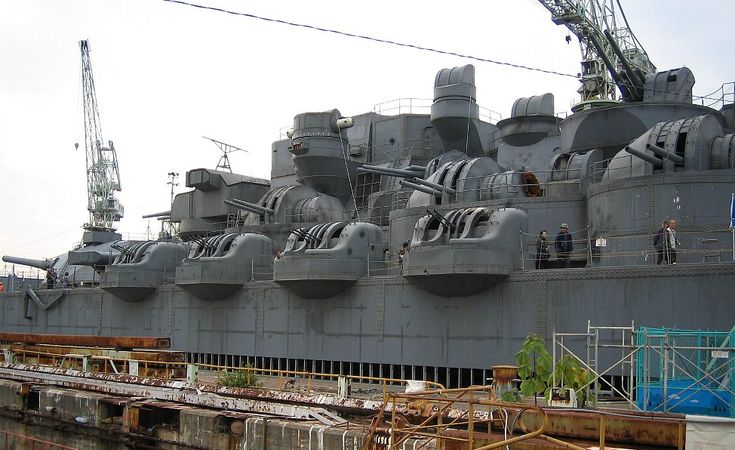
The secondary battery of the Yamato; as seen as a prop for the 1969 movie “Tora, Tora, Tora”.
The rivalry between Fujimoto and Hiraga appeared more obvious as the former secured his place front and center of the design process, also promoted admiral in November 1933 with the total backing of the Admiralty staff and had his pupil Ezaki to be later promoted Vice Admiral, his assistant as naval constructor. His Super Battleship Strategy with an all-forward battery and diesel propulsion was milited for unrelentingly, while Hiraga basically was sidelined. Hiraga nevertheless continued to lobby the naval staff with his personal designs from his position of chief of the research department. Whatever the case, Fujimoto and Ezaki ended drawing up ships that were close to unrealistic and even unsafe on a construction point of view. This influence was long lasting and some aspects would be found in the Yamato design as well. One design of the time, in 1935, by the team, showed a 67.000 tons standard design that was 301 meters long (990ft) and capable of 33knots speed based on a 6 shaft diesel propulsion. It was immune to 460 mm shells at the standard 20-35km range and had a triple forward main turrets arranged as the Mogami and the same superstructure bridge as for the rebuilt Hiei.

Author’s HD profile illustration of the Yamato in 1945
The demise and death of Design head’s Kikuo Fujimoto
For the sake of the design however, the influence of Fujimoto was eroded following the capsize of the TB IJN Tomozuru, in a heavy storm attibuted to insufficient stability margins. Iy happened in March 1934, and its design was basically a scaled down Fubuki. This incident was followed by investigations and the design defects were directly attributed to Fujimoto. His authority as design direction of the next battleship was severely weakened and he was eventually relieved of his post after investigations were completed, although he was very much also a scapegoat for the Admiralty Staff’s own responsibility and its relentless and unrealistic demands. When the latter was established, Fujimoto was recalled in January 1935, ony to pass out the next year. From there, Rear Admiral Keiji Fukuda took over the direction of the program, and a close relation to Yuzuru Hiraga. By October 1935 a new typhoon badly damaged several ships based on Fujimoto designs and investigations clearly indicated their weak hull structure was to be seriously revised. Ezaki, former Fujimoto’s protégé, was dismissed from the Design Bureau, but later reinstated by the Admiralty Staff but he was never allowed to design ships again, while he was found assigned to the hull strength calculations of the yamato nevertheless. Hiraga’s revenge, in a sense, was complete: After acting as temporary adviser he claimed later almost full control of the project, but calling his supporters in the Navy Minister and the Chief of the Admiralty. he was back on track to complete the design process of A 140.
Final race for the A140 design
In October 1934 chief engineer Fukuda Keiji, working with Hiraga, prepared a design for the official request, alongside Japan rejecting all treaties. Main battery as defined was to comprise at least eight 460 mm guns, complemented with 12x 150 mm or 8x 200 mm guns, and a top speed of 30 knots coupled with a range of 8000 nm at 18 knots, and an armor protection immune against 18-in AP shells in the usual 20 – 35km optimal ballistic tranche. The ASW protection was to include full protection against a 300 kg TNT warhread blast.
In March 1935, Fukuda Keiji (promoted admiral in 1941) prepared his first official plan integrating many features from Hiraga, notably his 1929 super battleship design. The armament and structures were concentrated in the center of the hull, on a 1/3 portion of the total lenght of the hull, well protected by a layered citadel. This presented the shortest possible armour lenght. Plates were of great thickness but all inclined to artificially reduce their weight. On this, Hiraga applied his own study of the Royal Navy’s G3 class to which he had access at the time, some featured passed onto the Nelson. However this was very much an exercize in excess, leading to a design so large it was unpractical. It was to be 965 feets long or 294 m and 135 inches or 41m wide, but moderate draft (10.4 m), so to fit in at least some existing naval facilities. Displacement of 69.500 tonnes and 200.000 shp output should grant a comfortable to speed of 31 knots and 8.000 miles range at 18 knots, but thanks to classic steam turbines. This design still had an all forward main battery, and everythng senstive including ammo rooms were inside the cidatel, leaving the rest of the ship, 2/3 of the hull, blast-free. No drawing survived of this variant, which could have included four triple 15,5cm turrets clustered on the aft deck, also place inside the citadel area.
Final Design development: A140
Departure from the League of Nations and renunciation of the Washington and London naval treaties allowed the engineers to delivere to the naval staff no less than 24 initial designsbetween March 1934 and 1936. They all varied in armament, propulsion, endurance, and armor although some basic characteristics were kept. For the main batteries the preferred caliber was still 460 mm (18.1 in) or 406 mm (16 in) and for secondaries, it was set to 155 mm (6.1 in) and dual purpose 127 mm (5 in), completed by an AA based on the 25 mm (1 in) gun. Propulsion showed still an influence of earlier ideas, notably to combined diesels and turbines, with just one proposal only still full diesel. Endurance was always calculated at 18 knots (33 km/h; 21 mph) and ranged from 6,000 nautical miles (11,000 km; 6,900 mi) for the A-140-J2 to 9,200 nmi (17,000 km; 10,600 mi) for the A-140A/B2. Protection also varied between protection at the usual ballistic range against 406 mm and 460 mm AP rounds.
A-140 design variants
April 1935: A-140A, B, C, D, A1, A2, B1, B2
So here we go: On 1st of April 1935, Fukuda directed a technical conference in which he prepared eight designs.
A-140A:
Mixed diesel-steam propulsion, 132 Kshp, 30 knots, 9200 nm/18 knots, 277 x 40 m for 68.000 tons standard, 430 mm belt, up to 584 mm barbettes, turrets, CT. 3×3 460mm/50.
The interesting and innovative aspect in this design was the cut down aft deck, with two catapults and ramp between the flight deck, main deck and hangar rather than a small elevator and space for 6 seaplanes stored under the middle deck and boat stowage tunnels with a top-rail running crane to serve them. These were retained for the Yamato final blueprints.
A-140B:
The all diesel variant, based on a 60.000 tons design, 28 knots but 9200 miles range at cruising speeds (18kn). 247m long only due to the smaller diesels, but same armour and armament ase above. No massive funnel, more space for AA and new distribution of the 12,7cm/40 mounts. The solution aimed at solving the protection problem of uptakes and smoke pipes.
A-140C & D:
Same all-diesel machinery, but sill two boilers and VTE to serve auxiliary power. Differences in the Version C was was to saved in the machinery by removing a fourth of the diesel engines, saving 2000 tons, therefore down to 58.000 tonnes, but speed now as low as 26 knots, based on with 105.000 SHP. Design D saved on secondary armament and armor to regain some speed, based on a 55.000 tonnes standard displacement and the same machinery as B, 29 knots. The main armament was indeed now tree triple turret with 41cm/53 guns, Nelson layout and belt thickness down to 15 inches (380 mm) thick for 8 inches mac armored deck (203 mm, layered down to 127 mm/5-in) gun turrets and CT with 18 inches (457mm), so 16-in immunity there.
A-140A1/A2/B1/B2
In this serie, Fukuda pushed forward his own solution of a more balanced approach for the main artillery, and other aspects. Despite the resistance for thr naval staff, he pressed foward with the solution which will be ultimately adopted, two forward, one aft, all triple. The idea behind was to avoid concentrating the main artillery at the same spot due to blast effects when firing in volley. Turrets were provisioned also to be upgraded to the 20 inches caliber (51cm) guns later. Fukuda soon also had the full support of Hiraga to convince the admirals of this arrangement as well. This redistribution was applied to variants which only differed by their the mixed powerplant, combining diesel propulsion and steam, but still with the A1 and B1 diesel alone. This was a risky move however, as so far only the Germans made an attempt in this direction with their serie of Deutshland class.
The problem with this configuration for protection was it forced the main magazines and citadel to be spread over 144 m versus 136 on the all-forward designs. Therefore, these vitals were also pushed closer to the outer plating, and this also complicating the secondary battery layout.
The 140 A2 variant, probably under influence of Hiraga, shown even an eight guns solution in twin turrets, two forward and two aft, the latter considerably pushed away from the funnel and aft mainmast. For all these variants, dimensions, displacement, armor and propulsion were similar. In the twin turret variants, the large 15,5cm/60 triple turrets were difficult to place. They were grouped around the aft pair, with two secondary facing forward tucked below the third main turret, not ideal due to massive interference and restricted fields of fire. There were also wing turrets, but their sub structures and magazines left with no space available. What did not changed much was the 127mm/40 emplacements. In general, the four twin turret layout had some tradeofs as its reduced firepower the main battery while having better fields of fire and greater secondary armament. In the end, the naval staff favored the A and B designs and decised to focus on them until the next conference, which was helf in May 1935.
May to August 1935 A-140G, G1-A, G0-A and G2-A
As a basis for propulsion it was preferred to keep a 1:1 ratio in the powerplant between steam turbine and diesel power, which also favored the “A” solution and its forward armament design. The A-140G presented in May answered this, with 41 cm/45 gun caliber and smaller dimensions:
oa lenght: 273m, 37.7m wide, 10.4 m draft, 65.800 tons standard, 70.000 SHP+70.000 SHP and 28 knots. Range 8000 nm, 4×3 secondaries.
A-140G1A was presented in June, with a hull shortened to 245 m oa, the beam pushed to 38.9 m for 61.600 tons displacement, and a 115.000 shp output for 26 knots.
A-140G0A was presented in July, this time longer at 268 m oa, Atago arrangement main battery layout, better aft firing arcs for the quad 155 mm guns. In August three smaller designs was alo proposed. These August variants had only 8 guns, with A turret being reduced to a twin turret. This coincided with the dimissal of Ezaki from the design team. So far, probably the A-140G2-A was the closest proposition in size and tonnage to the definitive design.
July 1935 designs: K and J series
-Design K was the shortest of all with only 221m long by 36m wide and a 10.1m draught, 50.060 tons displacement, only 24 knots.
-Design K3 was the largest of the serie, 246m x 37m, 28 knots on 130.000 SHP output diesel/steam. Both had 10x 46cm/45 guns.
-Design J0 was 242 x 36 m, but armed with 3×3 41cm guns, 52.000 tons, 27.5 knots on 120.000 shp.
-Design J2, same but with 67.000 shp (diesel/steam), 29 knots on 255 m length.
-Design J3 was 33% larger at 58.400 tons to accomodate four triple turrets with 46cm guns but on 252m long and 28 knots.
August 1935 Fukuda & Hiraga designs: F and I series
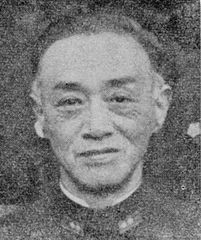 This last proposal by Fukuda Keiji, compounded by Hiraga’s own proposals tried to convince the NGS about a conventional artillery appraoch. Fukuda was noted A-140F, Higara A-140I. The latter mixed twin and triple turrets, 10 total but still 65.000 tons only and armor immunity against 460 mm AP shells, 15° slope for the belt.Both had the same range of 7.200 nm/16 knots.
This last proposal by Fukuda Keiji, compounded by Hiraga’s own proposals tried to convince the NGS about a conventional artillery appraoch. Fukuda was noted A-140F, Higara A-140I. The latter mixed twin and triple turrets, 10 total but still 65.000 tons only and armor immunity against 460 mm AP shells, 15° slope for the belt.Both had the same range of 7.200 nm/16 knots.
-Design A-140I: 268 m long, 38.9 m wide, 70+73.000 SHP, 28 knots, 2×2 + 2×3 (upper) main turrets fore and aft.
-Design A-140F: One aft twin turret was dropped, reducing the length to 247m, same beam, displacement down to to 60.350 tons, 130.000 SHP for 27 knots.
Eventually the naval staff was pleased by Fukuda design and ordered more: The F3, F4, F5 and F6 which were drawn in September:
This was the final stage of selection for more detailled design and production planning. F2 possibky appeared in early October 1935 and keeping the armament layout but with the forward turret No.1 now triple, requiring redesigning a fuller hull form at this point. The Powerplant was pushed 75.000 SHP on steam, but lowered to 60.000 shp for the diesels, so 135,000 total and 27 knots.
Next iterations played around the range and displacement. Initially F1/F2 had a range of 4900m/16 knots, on 57.700 tons. F3 seemed to have the same issue (no info available). F4 improved this by adding 2 m to the hull’ length for bigger tanks, incresing the range to 7200 nm, more suited for Pacific operations. Next was Design F5, dated from july 1935, with a mixed propulsion replaced by full steam turbine power, due to results and reports from unreliable Type 11 diesel engines which were tested at the time on IJN Taigei. The main issue was seemingly access for maintenance/repair. Hiraga also weighted for this decision and calculations for bunkerage were made over 150.000 shp, same range and the final lenght was pushed to 256 m on 64.000 tons (standard), basically very very close to the final design.
Armour design studies:
1– The Standard model: Armor belt sloped to 20° on the citadel, 25° forward & aft on the main transverse bulkheads. Variable height, higher part forward, smaller aft, connected with a 10° slope to the outer strake/lower flat part, tapered down to the double bottom behind a bulge.
2-Sloped strake: Equal height belt over the machinery and magazines, 20° above the waterline, tapered down to 12.5° angle to the torpedo BH.
3- Standard with 12.5° underwater slope and partial citadel, with protruding parts forward and aft.
4- uniform belt: For the whole citadel, dual slope 20° upper, 12.5° lower.
Also were studied a 12° slope for a 400 mm plate, 15° on 440 mm, vertical on 360 mm-480 mm-240mm in three strakes top to bottom, or a 20° sloped belt, 15° down.
Final drafts 1936-37: F3 to F6
Two of the original twenty-four were therefore chosen, namely Fukuda’s A-140-F3 and A-140-F4. They Differed in their range but served to draft the final preliminary study completed on 20 July 1936. The definitive design was ready by March 1937, signed by now promoted Rear-Admiral Fukuda Keiji. Final radius was 7,200 nmi, steam power with engines similar to those going to be mounted in new battleships. The main problems identified with diesels was to access them, some 200 mm (7.9 in) of the armored citadel deck roof was to be cut open to access the machinery spaces, complicating much this process. Final displacement was approved was 64,000 long tons (65,000 t), 69,988 long tons (71,111 t) fully loaded.
The F6 plan approved in 1936 led to order them in the frame of the Third Naval Armament Supplementary Programme FY1937 ‘Maru San Keikatu” plus two more FY 1938, 4th Programme “Maru Yon” named later IJN Shinano.
In Japan at this time, all knew this made the new class the largest battleships ever designed and constructed. The adoption of nine 460 mm naval guns which needed to redesign the hull was mostly a concern of ASW protection spaces on either side of the barbette. The Japanese Naval high command eventually approved the design despite a vivid opposition of the clique of naval aviators arguing that aircraft carriers were more promising (which is depicted in more detail in the “great war of archimedes” movie). But the conservatives, many veterans of the Sino-Japanese war, had the advantage in numbers and seniority. In all, no less than five Yamato-class were planned, two more later proposed (and cancelled in 1942). So this process started in 1935 and ended in early 1937, the first keel laid down in November (Yamato).
Construction
Needless to say, all three vessels were built in extreme secrecy. The Japanese were well aware of the efforts of American intelligence officials to obtain clues about them. Many military personal was present in Japan, even near December 1941. As a counter-intl effort, tjhe Japanese could have published fakes Specifications like the Germans did, but they rdecided otherwise. Both yards were covered by canvas and camouflage or fishing nets over the gantry cranes and structure, from a long period, as Yamato for example needed four years to be in shape to be launched, a record even for a capital ship. Usual work rarely lasted more than two years for this phase. The launch itself was kept secret, with no media coverage, and austere preparation for a very limited attendance. Workers on the site had their personal background checked, with detailed profiles provided by the Naval Yard, and body searches in and out of the yard, plus severe controls at any level for multi-level authorized personal. All blueprints were kept under lock and key at the yard and guarded by armed vigiles.
Due to these measures, the US Office of Naval Intelligence was effectively kept in the dark, and when the names of Yamato and Musashi’s emerged in late 1942, the USN assumed their specifications were basically closed to the Nagato class, but with the correct length, a thinner beam (110 feet or 34 m) and were far off as a result in displacement at 40,000–57,000 tons (not having armour details also played its part). The greatest interrogation was about their main armament, of nine 16-inch (406 mm), figures accepted as far as July 1945. Both Jane’s Fighting Ships maintained these specs for quite a while, written down from September 1944 and retaken by the New York Times and Associated Press or the Times of London. But in any case, they were believed to violate naval treaties, which weighted much in the development on the US side, of the 60,500-ton Montana-class as predicted by the Japanese early on. Between launch and completion, one and a half year passed for Yamato. Musashi was built faster, in 33-34 month, so about three years to launch, and one and a half year for completion too.
Construction called for several techniques, later raising issues: Arc welding technique was used in all the ship’s construction to strengthening the durability of the armour plating notably, and the lower-side belt plate strengthened the hull structure itself, sparing steel this way. Some of thiese construction techniques dated back from Hiraga’s time.
Design Particulars: Still a foggy battleship
It is important to note that these figures are all partly conjectural. By definition, all documentation reated to these ships, still conidered secret, were destroyed. It happened soon before the occupation of Japan, and was performed by special-service officers of the Imperial Japanese Navy. They meticulously destroyed all notes, records, drawings, and photographsrelated to the program. Which lefet only second-ghand data, and fragmentary records in between various engineers, notably Hiraga for the design development. This destruction was efficient enough to obscure all research until 1948, and all what the USN possessed was the few photos taken by aircraft recording the attack on both battleships. Over the years, fortunately part of photos and details surfaces, now extremely rare and prized. An international extensive research was done, speculative elements later confirmed in part by exploring the ships’s scaterred remains. Elements also came from interviews with Japanese officers after the surrender. The only exception to the rule was a visit by German Admiral Paul Wenneker, the German Naval Attaché in Japan. He was was allowed to inspect the IJN Yamato undergoing maintenance and cabled a detailed description to Berlin. Erich Groner (German naval historian) signed in 1943 the book Die Deutschen Kriegschiffe, 1815–1945, and was ordered by Hitler to do an “interpretation” and “design sketch drawing” of the Yamato class, fortunatelyu preserved by Erich Groner’s wife, submitted for publication in the 1950s.
Powerplant
The Yamato class as stated earlier was powered entirely by steam, 12 Kampon boilers (oil-fired) powering four steam turbines. In total, they provided an indicated horsepower output of 147,948 (110,325 kW). This power was passed on through the drive shafts to four equal size 6-metre (20 ft) bronze propellers. The Yamato class on contract was supposed to rearch 27 knots (50 km/h). This was ot far off other designs of the time, but far less than early “fast battleships” which were more interemediate designs such as the Frencn Dunkerque, German Scharnhorst, 30+ knots ships with reduced protection. The Yamato’s speed was better than modernized dreadnoughts but still unable to match the fast carriers envisioned for combined arms operations. Fuel consumption rate was also quite high and the intended radius was probably lower. This limitation severely limited their capabilities like travelling to the Solomon Islands and they also misses many of the “island hopping” campaign until early 1944. Stuck in Borneo, close to oilfields, at the time the invasion of the Philippines commenced was not due to random. The propulsion system of Shinano was improved in such a way she was capable on part to reach 28 knots (52 km/h), verified when she was briefly tested, as a carrier.
details of the way these turbines, boiler rooms and shafts, are still relatively foggy. We only know the exhausted truncated pipes connected to the boiler rooms were quite extended and that six separated boilers rooms were likely.
Armament
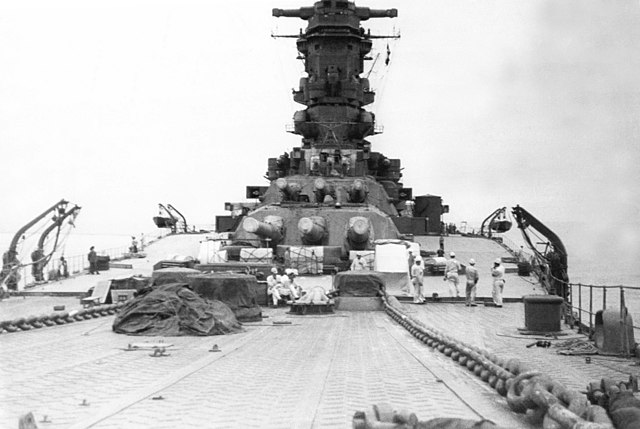
Main armament: Nine 46 cm
Yamato’s main battery consisted of nine 46-centimetre (18.1 in) 45 Caliber Type 94 naval guns.
These were simply the largest caliber in naval artillery history to ever land on an operational warship. It should be noted however shells were slightly lighter than the British 18-inch shells, back to World War I.
45 caliber Type 94 40 cm Gun characteristics:
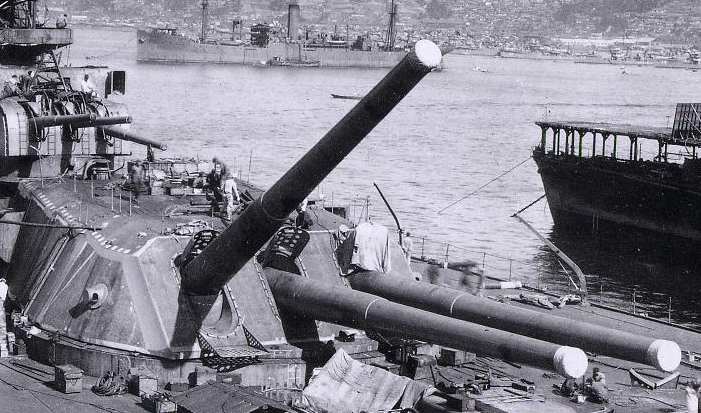
Each turret famously weighted as much as a destroyer. Each gun was shielded from the others in its own compartment for safety.
Production started 1938, total 27 produced
-The barrels alone measured 21.13 metres (69.3 ft) long for 147.3 metric tons overall
-Welin breech block, Hydraulic recoil mechanism
-Elevation +45/-5 degrees. 10°/s
-Traverse 300° at 2°/s
-Rate of fire: 1.5 – 2 rounds/min
-Muzzle velocity: 780 m/s (2,600 ft/s)
-AP shell Type 91: 1,460 kg (3,218.7 lb)
-HE Type 0 shell: 1,360 kg (2,998.3 lb)
-AA Type 3 shell: 1,360 kg (2,998.3 lb)
-Max elevation performances: 45°: 45,960 yards (42,030 m) 98.6 sec
-Impact angle: 23.2° at 32,810 yards (30,000 m), 31.4°: 1,558 feet per second (475 m/s)
-Effective firing range: 25 km (16 mi)
-Maximum firing range: 42 km (26 mi) at 45° elevation
-Both HE and AP shells had a range of 42 kilometres (26 mi) -close to the USN 16″/50 Mark 7.
-Operational use: Battle off Samar October 1944 and with “beehive” shell against US aviation
-180 shells per turret (60 rounds per gun) stored, 560 in all.
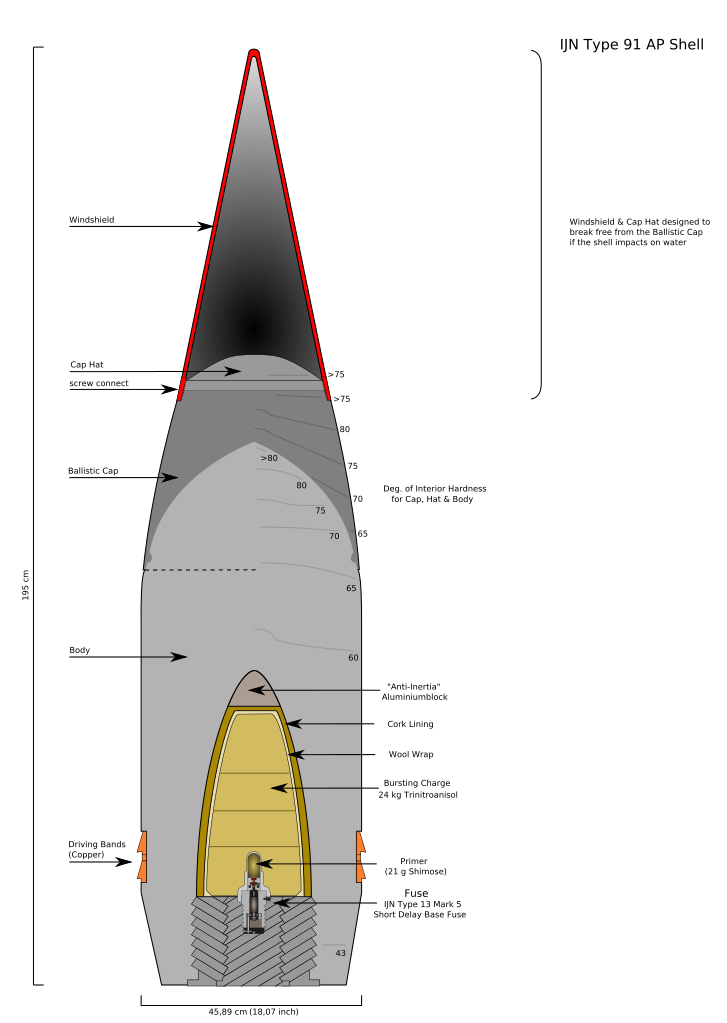
Notes: Dispersion was very limited, with spreads up to 440 to 550 yards (400 to 500 m) off as recorded and confirmed by observations at Samar. In 1945, two test guns at Kamegakubi were demolished in November, but other captured and tested back in the US, No. 23 and No. 27, at Dahlgren Proving Grounds in Virginia.
Read more: //navweaps.com/Weapons/WNJAP_18-45_t94.php
Secondary battery: Twelve 155-millimetre (6.1 in)
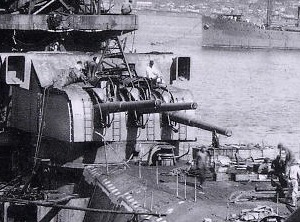
These guns were distributed in four triple turrets (one forward, one aft, and the last two midships). They were from the Mogami-class cruisers turrets when the latter converted to a main armament of 20.3-centimetre (8 in) guns.
Notes: Designed in 1933 at Kure Naval Arsenal, 80 built from 1935.
-Barrel weight 12.7 metric tons (28,000 lb)
-9.615 metres long overll, 9.3 metres (31 ft) barrel only
Shell eight 55.87 kilograms (123.2 lb) AP/HE
-155 millimetres (6.1 in)/60 caliber
-Elevation: -7° to +45°
-Rate of fire: 5 rpm
-Muzzle velocity: 925 metres per second (3,030 ft/s)
-Maximum firing range: 27,400 metres (30,000 yd)/45°
Dual Purpose battery: Twelve 127 mm (5 in)
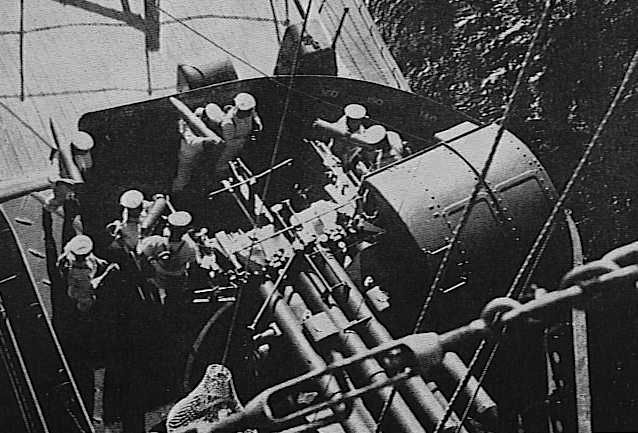
The Yamato class were given twelve 12.7-centimetre (5 in) guns, spread in six twin mounts mounted on each side amidships.
With time, it was increased to double that number by ermoving 155 mm amidship turrets. These were old models in 1941 already and obsolete as shown in 1944-45.
Specifications 12.7 cm/40 Type 89 naval gun
Designed 1928–32, production from 1932 to 45, circa 1500
Barrel weight 3,100 kilograms (6,834 lb)
Barrel length 5 m (16 ft 8 in)
Shell type: Fixed 127 x 580 mm Shp, 20.9–23.45 kilograms (46.1–51.7 lb)
Mechanism: Horizontal breech block
Elevation: -8° to +90°
Rate of fire: 8-14 rounds per minute
Muzzle velocity: 720–725 meters per second (2,360–2,380 ft/s)
Maximum firing range: Ceiling 9,440 meters (30,970 ft)/90°, range 14,800 meters (48,600 ft)/45°
AA battery: Twenty-four 25 mm (1 in)
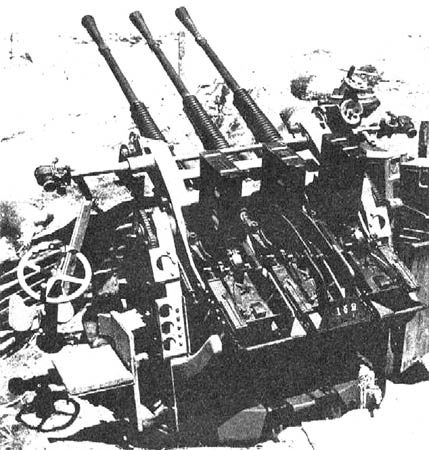
The Type 96, 25 mm AA gun was probably the most ubiquitous piece of Ordnance in the iJN/IJA inventiory as it also served as a tank gun and antitank gun as well. Derived from the French Hotchkiss 13.2 mm heavy machine gun, loaded with clips.
In addition, Yamato carried 25 mm (1 in) AA guns, were mostly mounted amidships in triple mounts. The refits of 1944 and 1945 added many more.
In 1945, the secondary battery configuration was down to six 155 mm guns, the amidship turrets retired to make way for twenty-four 127 mm guns, and 162 25 mm guns, in triple and single mounts
Fire control Systems
The Imperial Japanese Navy used the standard analog mechanical ballistic computer during World War II, after earlier experience with Britsh ballistic mechanical computers and Barr & Stoud rangefinders.
-Type 92 Shagekiban Computer: Used for 41 cm, 36 cm, 20 cm, and 15.5 cm artillery
They were setup to calculate a future target position and send coordinated by using available input from the director and rangefinders, but also the gyros. The IJN industry in this sector had a young and restricted industrial base, plus fewer resources. Fire control systems were generally less automated and relied on more data and operators to properly function.
The Imperial Japanese Navy’s systems were originally based on data management and techniques inherited from the British Royal Navy. During the interwar period components and techniques were mostly replicated and perfected, leading to a domestic industry for these systems.
The Type 92 Shagekiban computer digested data from the following systems:
-Type 94 Hoiban director
-Type 92 Sokutekiban rangefinder
-Ship’s master Compass
-Correction data about trajectories, shell weight, wind and spot)
The result usable orders were basically only the future target position. These outputs were sent back the Type 94 Hoiban director, such as lateral deflection and elevation.
These data were different for all set directors, for setting and training. Parallax, roll, cross corrections joine the data and the final orders given to the guns via the simple and proven “follow the pointer” device.
Manufacturer and designer was the Aichi Clock Company which produced the Type 92 Low Angle analog computer in 1932. It needed to rely on the Hoiban Director called “Sokutekiban” for the real-time calculations. Its panel was split into 7 operator displays, a Graphic Plotter also depicting the bearing rate and the range averaging panel, in order to select best ranges from various rangefinders.
Onboard Aviation
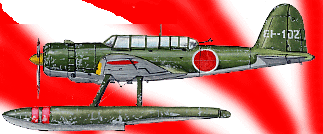
-7 Nakajima E8N “Dave” (1935) were planned to be in service on the Yamato when completed. Although rather obsolete, they could perform their reconnaissance and spotting missions over 900 km or 580 nm. About 750 Navy Type 95 Reconnaissance Seaplane Model 1 were produced, and they were pure observation planes, only carrying two 30 kg (66 lb) bombs if needed.
-1942: This provision was changed to four Aichi E13A and three Mitsubishi F1Ms.
–Aichi E13 (illustration above, by the author): Modern monoplan cantilever observation/spotter and reconnaissance plane, introduced in 1941. Over 1500 built, they could fly at 376 km/h or over 2,089 km (1,298 mi, 1,128 nmi) at 220 kph and carry 250 kg (551 lb) of bombs underwings in addition to two 7.7 mm (.303 in) Type 92 MGs and for a few, 20 mm guns.
-Mitsubishi F1M “Pete”: More powerful, capable of 370 km/h and better armed, it was still an obsrvation planed, but usable as fighter if needed, although two fixed forward-firing 7.7 mm (.303 in) Type 97 aircraft machine guns and a defensive ones were a bit light for the purpose. Range was limited to 750 km and they only carried 2 × 60 kg bombs.
Aviation facilities: 2 catapults, hangar below, several railings for storage/parking, single lift, workshop and spares, aviation gasoline tanks.
Armour Protection
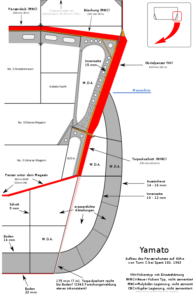 Yamato was originally designed to engage several battleships at once and so present any angle to enemy fire. Its heavy armour plating was described by naval historian Mark Stille as the best designed so far.
Yamato was originally designed to engage several battleships at once and so present any angle to enemy fire. Its heavy armour plating was described by naval historian Mark Stille as the best designed so far.
Details of the protection
Main belt: 410 millimetres (16.1 in), transverse bulkheads (citadel): 355 millimetres (14.0 in). Lower belt 200 mm (7.9 in).
It resulted moslty from gunnery experiments made on Tosa and with the new Type 91 shell which had a better velocity underwater than other models.
The top hull had Sideways curving maximizing armour protection, structural rigidity and weight saving.
-Main turrets: Front plating 650 millimetres (26 in), Vickers face-hardened steel armour.
-Main armoured deck: 200 millimetres (7.9 in), nickel-chromium-molybdenum alloy (Kamegakubi tests*), over 75% of the ship’s size, and up to 230 mm (9 in) armored deck, for around 25% of the ship, bascically the citadel.
*They showed in ballistics tests better resistance, of about 10 to 15% above the homogeneous Vickers armour.
Add-on plating using an alloy with better chromium and nickel composition with more nickel for rounded and rolled parts.
-Submarine torpedo protection: Several longitudinal bulkheads and void spaces in between connected to the lower belt armour, 5.1 metres (16.7 ft) deep. Proof against a 400 kilograms (880 lb) TNT charge. The absence of liquid fuel spaces were in part to provide additional counter-flooding spaces, which was found handy near the ships’s end, compensating from many torpedo hits. In all, this underwater section was divided into 1,147 watertight compartments, most under the armoured deck. There was still, taks to the great width, a large reserve of buoyancy to mitigate blasts and flooding. It took nearly 20 aerial torpedoes to sink both battleships, and counter-flooding at some point almost succeeded in reducing list to 1-2%, quite manageable.
A crucial design flow
Armour thickness however was not anything. There could be the Achilles heel of an unprobable lucky hit (likely for the Hood), or another overlooked aspect that ruined all statistics. In her case, the Yamato class suffered not from one, but several major design flaws. Near the unprotected bow armour plating was quite thinner. Musashi showed it by extensive damage after a torpedo hit in 1943. Shinano’s hull was even weaker due to her hasty construction and incomplete armour. The torpedo defense system performed poorly, far less well than expected, because of the jointing between the upper-belt and lower-belt armour plating. Indeed, the link etween plates was riveted, not welded as there was no technique at the time to weld together such thick plates. This weakness created a seam just below the waterline. When the latter was pressured with excessive flooding due to the shallow system depth and lack of liquid filling. Some cluse about this were found in the 2008 survey and this joint failure was perhaps the main reason behinf Yamato’s extensive damage caused by a single torpedo hit in 1943. She was dangerously weakened in a place nobody could maintain or investigate, and should have withstood many more torpedoes in 1945. This weakness (and other issues, see later) were also probably the reason Shinano sank after just four hits in 1944, despite her own crew’s confidence.
Detailed Specifications
Dislacement:
69,988 long tons (71,111 t) (trials)
72,000 long tons (73,000 t) (full load).
Dimensions
Length: 256 m (839 ft 11 in) waterline, 263 m (862 ft 10 in) (o/a)
Beam: 38.9 m (127 ft 7 in)
Draught: 10.4 m (34 ft 1 in)
Powerplant:
4 shafts, Miyabara turbines, 12 water-tube Kampon boilers
Output: 150,000 shp (110 MW)
Top Speed: 27 knots (50 km/h; 31 mph)[3]
Range: 7,200 nmi (13,300 km; 8,300 mi) at 16 knots (30 km/h; 18 mph)
Complement: 2,767
Armament:
-3 × triple 46 cm (18.1 in) guns
-4 × triple 15.5 cm (6.1 in) guns
-6 × twin 12.7 cm (5 in) guns
-8 × triple 25 mm (1 in) AA guns
-2 × twin 13.2 mm (0.52 in) machine guns
Armor Protection
-650 mm (26 in) on face of main turrets
-410 mm (16 in) side armor (400 mm planned on Shinano and No. 111), 20° slope
-200 mm (8 in) armored deck (75%)
-230 mm (9 in) armored deck (25%)
Aircraft
-4 Aichi E13A, 3 Mitsubishi F1M, 2 catapults
The Yamato class in action
Despite all of their apparent might, which masked some technical issues as we saw, both battleships were kept relatively out of harm from most of the war, until the situation was desperate enough to try to reverse it. Basically after years of inactivity, both ships were thrown away in near-suicide missions, and destroyed by aviation, not the other battleships both were intended for. We will never know how they would have done for example against the Iowa class, their on-paper enemy.
IJN Yamato (16.12.1941 – 7.4.1945)
Trials and initial operations
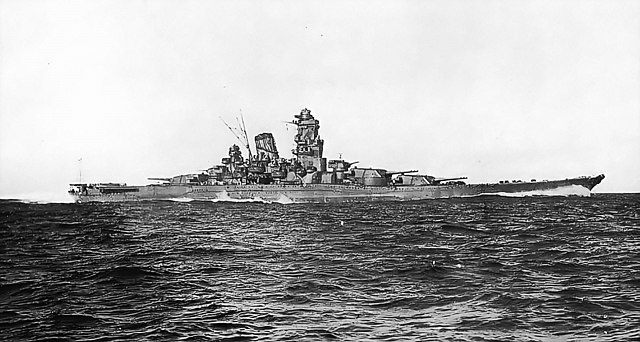
Yamato during sea trials in October 1941
In October-November 1941, IJN Yamato underwent her sea trials, and pushed her machinery to reach 27.4 knots (50.7 km/h; 31.5 mph). War was closed and the admiralty wanted to press on with her commissioning, and after her post-trials refit which was botched up, she was in service by 16 December, months ahead of schedule in Kure. Like her launch, this was a secretive ceremony, quite austere and restricted. There was not a single headline in the news. Captain (and later Vice-Admiral) Gihachi Takayanagi took command. She took her place with the IJN Nagato and Mutsu, making the 1st Battleship Division, by far the best capital ship squadron in the Pacific, at least in quality. Their intended enemy was “battleship row” in Pearl Harbor. But by the time she was commissioned, the attack ended and the distant cover squadron placed to the north was to supposed to finish off any USN battleships that would try to escape, and cover the retreat of the Kido Butai.
The Yamato at Midway (June 1942)
On 12 February 1942, IJN Yamato became flagship, bearing the colors of Admiral Isoroku Yamamoto’s at the head of Combined Fleet. She was the tip of the spear. Yamamoto was both a veteran of Tsushima and supported of new ideas, notably aviation and combined arms tactics. He also planned Pearl Harbor, and now planned an operation to finish off the missing aircraft carriers from Pearl Harbor. Virtually anything that can still pose a threat for the IJN in the Pacific. The decisive engagement was planned at Midway Island and preparations were made in April. The mixed results at the battle of the Coral sea in May did not changed overall plans, but only comforted the IJN as they sank the Lexington and badly damaged the Yorktown, for the loss of a light carrier. After participating in war games, IJN Yamato departed Hiroshima Bay on 27 May 1942 as part of the main battleship group. US codebreakers however decrypted messages and eventually knew about Yamamoto’s intentions and moves. The Battle of Midway sealed the fate of the Kido Butai and reverse the odds of Pacific Campaign on its head. Japan lost tat day in June four fleet carriers and 332 aircraft with very experienced pilots. Yamamoto during all that time was providing distant cover from Yamato’s bridge. His forced were widely dispersed as he wanted lure the Americans out into a trap, but the battleship group was by then too far away. On 5 June, Yamamoto, which until then had waited for the US fleet to arrive and allow him to start a night engagement. He decided to return to Japan and withdrew the main battleship force to Hashirajima, and Kure.
The Yamato in Truk (August 1942-December 1943)
Yamato left Kure for Truk on 17 August 1942 and underway after 11 days, the battleship was sighted by USS Flying Fish, which fired four torpedoes but missed. IJN Yamato arrived in Truk the same day and remained there during Guadalcanal Campaign. She could not intervene as not having her complement of 18 inches ammunition for shore bombardment. Another fear were the uncharted seas around Guadalcanal, and she could have been grounded. Also her high fuel consumption was of some concern. Captain Matsuda took command during this period. From 11 February 1943, IJN Yamato was relieved by Musashi, as flagship of the Combined Fleet. She departed on 8 May 1943 for Japan, reaching Yokosuka and headed to Kure, where she arrived on 14 May for nine days in dry dock, maintenance, inspection and repairs. She then departed for the western Inland Sea, dry-docked again in late July for a refit and some upgrades. On 16 August 1943, IJN Yamato was back to Truk, joining a large task force assembled to prey on the US fleet attacking the Tarawa and Makin atolls. In late September she sailed out with IJN Nagato and three carriers, plus their escort of smaller warships. Their target was Task Force 15. They missed it, as the latter departed, and tried again a month later with a force this time six battleships strng plus three carriers, escorted by eleven cruisers. Japanese Intelligence services reported Pearl Harbor was nearly empty and the admiralty thought this force was to strike at Wake Island. The Japanese ships had radar but made no contacts for six days, not their observation planes, and for six days they searched in vain, before folding up and returning to Truk on 26 October 1943.
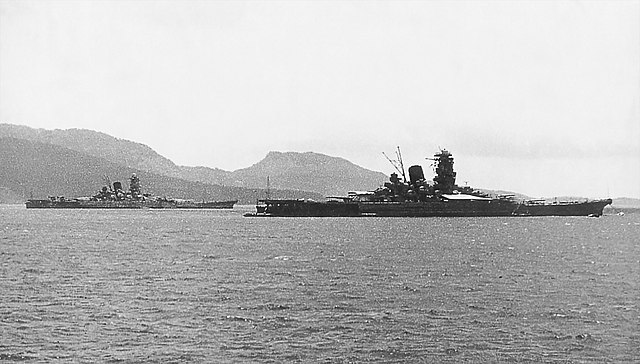
Yamato and Musashi anchored in Truk Islands waters in late 1943
IJN Yamato sailed to Yokosuka, escorting a convoy (Operation BO-1) from 12 December 1943 and she herself carried troops and equipment to reinforced garrisons at Kavieng and Admiralty Islands. She ferried these from Yokosuka to Truk and back. Her task group were spotted and attacked underway by USS Skate. The submarine fired four torpedoes at Yamato and one hit her starboard side, close to the stern. This created a gash 5 metres (16 ft) high, below the anti-torpedo bulge 25 metres (82 ft) long. Joint between the upper and lower armored belts failed, and the flooding went also in rear turret’s upper magazine. IJN Yamato reached eventually Truk with 3,000 tons of seawater and was taken in hands by the repair ship Akashi for temporary repairs. She departed on 10 January for Kure and arrived in January 1944 for repairs, dry-docked until 3 February. Engineers fitted her with a new armor plate sloped at 45°. Additional protection proposals were rejected as not to increase more her draft. Captain Nobuei Morishita (formerly on IJN Haruna) took command ad Yamato was re-affected on 25 February with her sister ship to the Second Fleet. Still dry-docked, Yamato was also fitted with a Type 13 air search and Type 22, Mod 4, surface search/gunnery control radars and all her anti-aircraft guns and fire controls were upgraded, until 18 March 1944. Her two beam 6.1 inch (155-mm) triple turrets were removed, making way for three additional twin 5-inch (127-mm) turrets and 8 triple and 26 single 25 mm AA guns were added, for a grand total of 25x 5-in and 162x 25 mm AA guns and shelters on the upper deck for the AA crews. The main mast was also modified and she received infrared identification systems plus aircraft search and gunnery control radars. On 18 March she left the drydock and started her post-refit trials from 11 April, up to 21 April when she sailed for Okinoshima, to embark soldiers and equipments to reinforce Manila. She arrived in the Philippines on 28 April 1944 and moved to Malaya, joining Vice-Admiral Jisaburo Ozawa’s Mobile Fleet based at Lingga, stopping at Tawi Tawi on 14 May 1944.
Battle of the Philippine Sea (June 1944)
In early June 1944, Yamato and Musashi were used as troop transports, bound for the island of Biak (Operation Kon), but it was was cancelled when Ozawa knew of the attack on the Mariana Islands. The Imperial Japanese Navy decided to concentrate its remaining battlefleet core in order to mount a decisive, last ditch attack. From 19 to 23 June 1944, IJN Yamato escorted Ozawa’s Mobile Fleet at the Battle of the Philippine Sea, and its early phase called “The Great Marianas Turkey Shoot” when the Japanese lost three aircraft carriers and 426 aircraft. Yamato at the end of the battle mistook returning Japanese aircraft for US attack planes and fired on them with her AA until they were identified.
Yamato like the Mobile Fleet sailed to Hashirajima near Kure, refuelling and rearming for the next operation. In this one, Yamato teamed with Musashi, leaving for Kure on 24 June. There, she was rearmed with five more triple 25 mm AA guns, while safety was improved, notably with the “emergency buoyancy keeping procedures”. It consisted in the removal of nearly all flammable materials such as linoleum bedding and mattresses. As a result, “Hotel Yamato” as she was famously known obliged the men to sleep on planks usable to repair battle damage and flammable paints were scrapped out or covered by a new silicon-based overcoat. While safety teams were retrained, they also received portable pumps and improved fire fighting systems. Yamato left the archipelago on 8 July with Musashi, Kongō, Nagato, and eleven cruisers. The formidable twins arrived at the Lingga Islands on 16–17 July 1944 by which time the IJN tanker fleet was mostly gone due to the action of USN submersibles, the East Indies providing now this fuel supply. Yamato and Musashi remained here for three months.
Battle of Leyte Gulf
Battle of Leyte Gulf (October 1944)
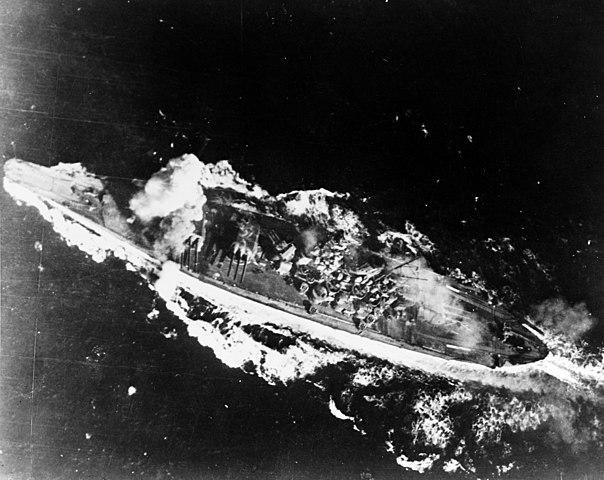
Yamato hit by a bomb during the Battle of the Sibuyan Sea, 24 October 1944, without serious damage
In 22-25 October 1944, Yamato was part of Takeo Kurita’s Center Force (also “First Striking Force”) and at least she took part in her first serious naval engagement of the war: The cataclysmic Battle of Leyte Gulf. Operation Shō-Gō conducted this main force and another to rally to the island of Leyte, to destroye the US landings there. On 18 October, IJN Yamato was painted in a black camouflage for her nighttime transit through the San Bernardino Strait, made of soot from smokestack painted on her flank with some oil. En route to Leyte, the fleet was ambushed in the Palawan Passage on 23 October by USS Darter and Dace. They sank Atago (Kurita’s flagship) and damaged another cruiser, while Kurita survived and transferred his flag to Yamato.
Soon, she would be taking part in the Battle of the Sibuyan Sea.
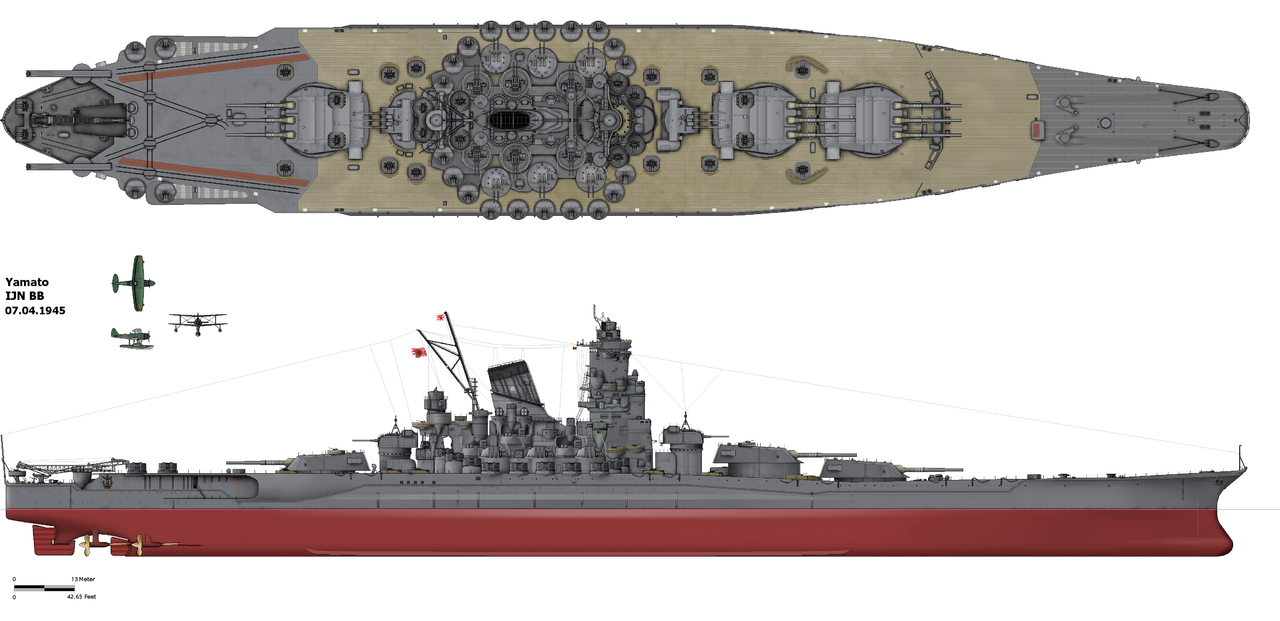
Appearance of the Yamato in 1945.
It happened the following day for the Center Force. It fell on a prepared TF 38, this October 24, 1944 (Halsey). Task Force 38’s aircraft attacked this Raiding Force right away as it was spotted, in the Sibuyan and Sulu Seas. The 1st strike force lost three more heavy cruisers, which took away a large chunk of the anti-aircraft defence, and during this long day of fury, USN carrier aircraft sortied 259 times, notably those from USS Essex which claimed a hit on Yamato with two armor-piercing bombs, and a near miss. Yamato however only suffered moderate damage but took 3,370 tonnes of seawater, she went on soldiering until night fell. Her sister ship Musashi was not so lucky. Like a magnet she drawn the attention of attackers and was hit with 17 bombs and 19 torpedoes while the battleships Nagato, Fuso, and Yamashiro were badly damaged as well as numerous destroyers. In return, the Japanese claimed the fleet carrier USS Princeton (CVL-23), which collided with USS Birmingham (CL-62). The destroyers USS Morrison (DD-560), Gatling and Irwin assisted her before she was scuttled.
Battle off Samar
Information was key in these pre-satellite era: Indeed, the main American battle group (Admiral William Halsey, Jr) departed the Leyte Gulf area on 24 October, convinced that Kurita’s Center Force has been effectively knocked out, sailed his Task Force 38 away in hot pursuit of the bait Japanese Northern Force, a deception which was a success, as it drew Halsey’s five fleet carriers, five light carriers escorted by six fast battleships and eight cruisers plus 40 destroyers out of harming the Japanese. Kurita’s night navigation in the the San Bernardino Strait was nothing short of a trumph of seamanship, and when he exited shortly after dawn off Samar, he was ready to proey on the main objective as intended, the USN amphibious force. “Taffy 3” was small carrier group centered around six escort carriers, slow and small, their planes already busy covering advaning troops. Their only escort was three destroyers and four destroyer escorts.
It is not even sure the destroyers spotted the approaching fleet by radar, they were surprised by Yamato’s first volleys at very long range. She was for the first time able to hit several American ships present, hitting in particulary the escort carrier USS Gambier Bay. She was close to do the coup de grace when her spotters saw a spread of torpedoes heading for her. She violently steered away to avoid them and could not return to the battle for a time. In this battle, USN destroyers made a serie of daring attacks, well supported by FM-2 Wildcats and TBM Avengers from Taffy 3’s escort carriers. Their ferocious defence astonished Kurita which believed he was meeting a full American task force, compounded by a mistaken report reporting six fleet carriers and three cruisers plus two destroyers. Kurita decided to disengage and withdraw his task force. Yamato’s only fear was three near misses which caused seventeen casualties, from strafing attacks, and later carrier strikes during the retreat, making 21 more casualties. The Japanese would lost that day three more heavy cruisers and a light cruiser, claiming a single American escort carrier two destroyers and a destroyer escort. TF3 and the landing force was left largely unscaved and afterwards a second CVE was sunk by a kamikaze attack.
Yamato escorted Kurita’s force to Brunei, and refuel. On 15 November 1944, the 1st Battleship Division was disbanded. IJN Yamato became the flagship of the Second Fleet and on 21 November, as was underway in the East China Sea in order to reach Kure, the battle group was ambushed by USS Sealion. Kongō and the destroyer Urakaze were torpedoed and sank. Yamato was sent in drydock for maintenance and repairs, and her AA battery upgraded and extended for the last time. On 25 November, Captain Aruga Kōsaku took command.
Operation Ten-Go (The strike of Okinawa)
On 1 January 1945, Yamato, Haruna and Nagato, duly maintained and resupplied, formed the 1st Battleship Division, prepared for further actions despite the lack of fuel oil. Yamato was briefly reassigned in the 1st Battleship Division from 10 February and she was sent to escort the 1st Carrier Division to Kure. On 19 March, USS Enterprise, Yorktown and Intrepid launched their air groups to raid Kure and hit 16 warships, including IJN Yamato, but she suffered only minor damage. Most from near misses and one hit on her bridge. The raid was somewhat perturbed by a squadron of veteran pilot instructors in their good Kawanishi N1K1 fighters “George”. Yamato saved herself by manoeuvering in the Nasami Channel to safety. The invasion of Okinawa started on 1 April 1945, and the IJN planned Operation Ten-Go. What remained of Japan’s surface forces were to be thrown in a final battle against invasion forces, consisting by then of Yamato, the cruiser Yahagi and eight destroyers. With what was remaining of fuel oil, they would launch a surprise attack on Okinawa in concert with kamikaze units. After Yamato wa to scatter the USN force, she was to be beached and act as a fortification to sopport the resisting garrisons, until destroyed. This was a one-ticket mission and Yamato carried for it its full stock of ammunition. She was prepared on 29 March, her sailors doing the same ceremionial and mental preparation Kamikaze did. Outpassing the admiralty’s orders, local base commanders gave a complement of 60% capacity more oil to the battlesip, now the centerpiece of the newly designated “Surface Special Attack Force”. It left Tokuyama at 15:20 on 6 April, but the USN was well aware of this move due to intelligence decryption.
Around 20:00 this IJN force was spotted across the Bungo Strait bu the submarines USS Threadfin and Hackleback. They reported Yamato’s position but could not attack themsmelves as now the IJN were too fast, at 22 knots and doing extreme zigzagging. Lessons were learnt the hard way. This zig-zagging was not the best course of action to spare oil though, but the addition given at the start granted this extra consumption. But now the next perile was on.
While the landing Allied forces and covering Task Forces prepared for an assault, Admiral Spruance despatched his six battleships, until then doing shore bombardment, to face the Yamato. Eventually air strikes were ordered by Admiral Marc Mitscher, while the battleships and 7 cruisers were still sent to interdict the way to the landing force as a backup. Yamato was prepared for battle, all anti-aircraft crew on the ready when dawn came on 7 April. The first wave spotted the IJN force at 08:23, later positions confirmed by two flying boats. For the next five hours, IJN Yamato would fire all what she had on the successive waves. Even her main turrets and massive 18-in guns were put to contribution, firing the Common Type 3 “Beehive” (3 Shiki tsûjôdan) shell. The latter was baslically a giant grapeshot, which success was limited. It could have theoretical advantage on massed formation, but nothing could really prevent her fate. First radar contact of USN air groups was made at 10:00 and at 11:00, the first F6F Hellcat fighters started to strafe her decks to clear off AA fire after they initially searched for any Japanese aircraft. They prepared the way for waves after waves of torpedo bombers which arrived over the Yamato from 12:30. In all, 280 Curtiss Helldiver dive bombers and TBM Avenger torpedo bomber attacked.
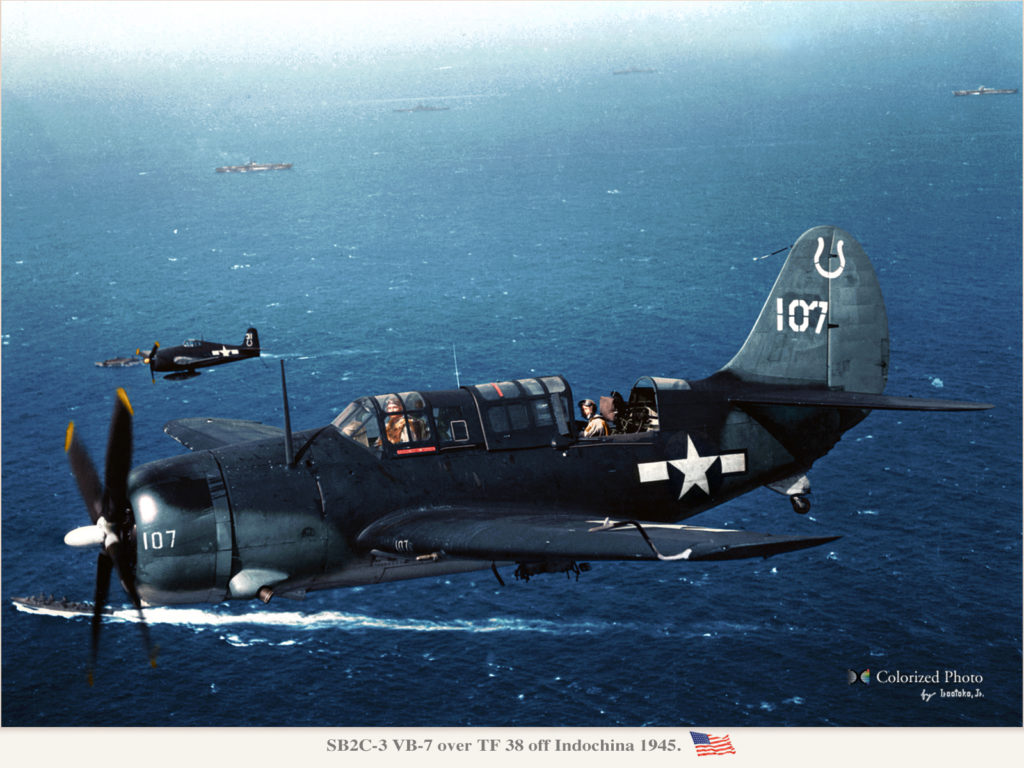
Curtiss SBC Helldiver
The fleet was deprived of the destroyer IJN Asashimo, which stayed back because of engine trouble, and late eliminated by planes which took off from from San Jacinto. The rest of the fleet deployed a curtain of steel on the USN air onslaught. The Surface Special Attack Force was now running at 24 knots and after Yamarto deployed its AA battle order, escort destroyers started circling her. First serious attacks started at 12:37 and IJN Yahagi made large swoops at 35 knots in an attempt to draw off some attackers, in vain. At 12:41 Yamato was hit by two bombs which destroyed some triple 25 mm AA mounts and torned open the deck. A third one struck her radar room and blasted the 127 mm mount nearby. At 12:45 a torpedo struck her port far forward. At 12:46 two more bombs hit her port side aft of the 155 mm middle turret and another on top, blewing it up as its magazines. She then took three more torpedoes hits, two on the port side, close to the engine room and boiler rooms, and a third probable (Garzke & Dulin), likely causing the flooding in Yamato’s auxiliary steering room. This wave stopped at 12:47. Yamato was listing 5–6° to port, but counter-flooding reduced it to 1°. One boiler room was disabled and top speed fell, while the decks were soaked with the blood and debris of strafed AA guns and men. The unprotected 25 mm AA guns were indeed unprotected and needed much manpower.
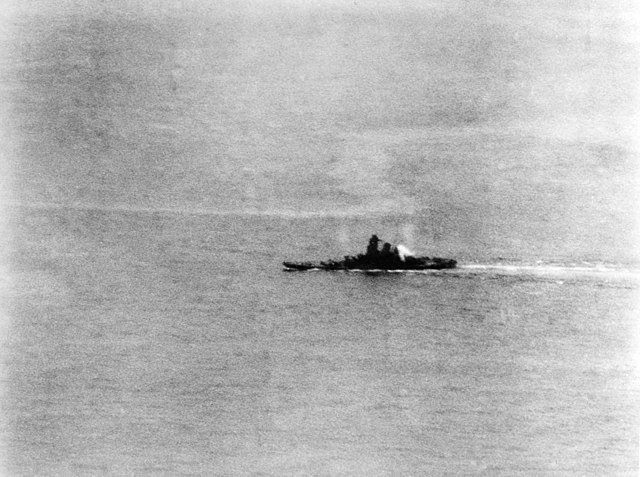
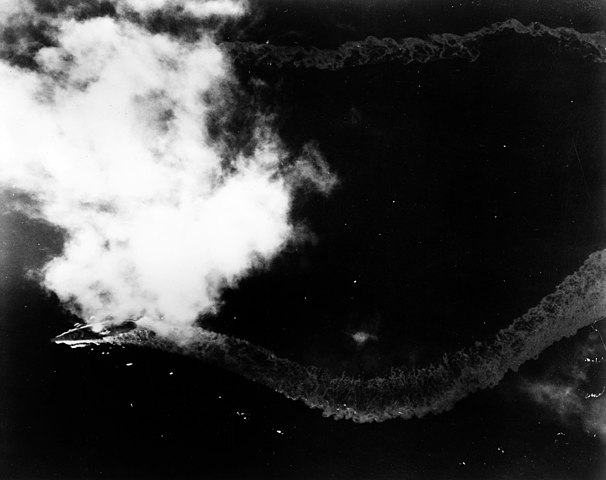
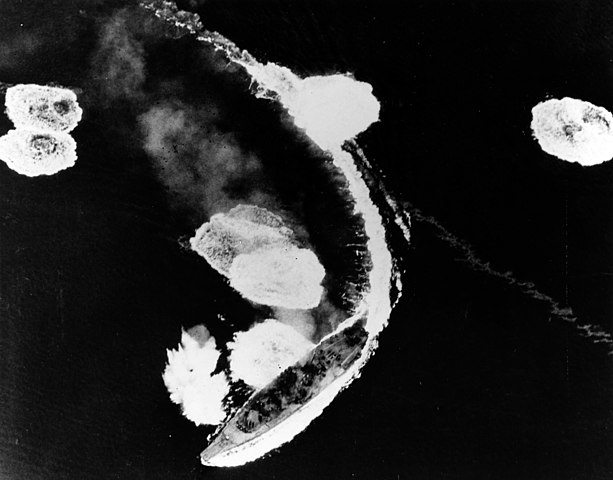
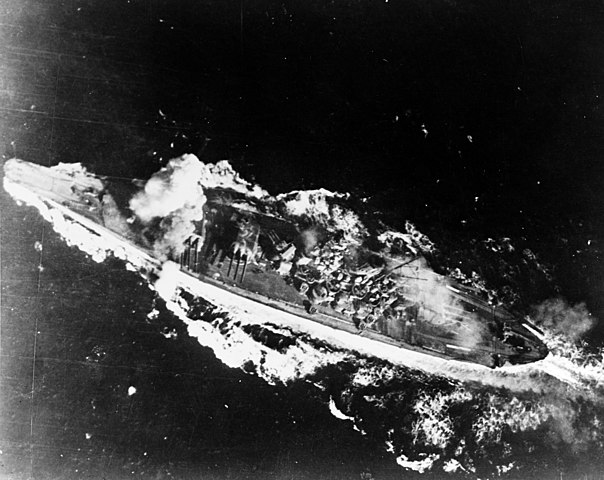
Yamato manoeuvring during the attack, and later photographed during the battle one USS Yorktown (CV-10) plane, on fire and visibly listing to port.
The second waved arrived at 13:00. Dive bombers started high overhead coordinated with the low-flying torpedo bombers, coming from all directions. The number of targets made any AA defense too ineffective, including repeated volleys from Yamato’s main guns’s Beehive shells at around 1,000 m (3,300 ft) distance. Three or four more torpedoes soon impacted the Yamato, three port and one starboard. The hits close together on the port side struck a fire room and closed to an already damaged outboard engine room. Flooding increased again, with another hit aft of the third fire room. This time, the battleship was listing 15–18° to port and counterflooding of all remaining void spaces starboard helped reducing this to 10°. Now only repairs could do anything. At present, the angle was such the main battery cold not fire any longer while speed fell to 18 knots. The third, fatal wave, started at 13:40. Yamato took four comfirmed bombs hits on her superstructure while more 25 mm AA stations were disabled. There were also many near misses which disjointed her outer plating. Due to her assembly, it was likely to happen and now her all ASW protection was compromised. She soon also took four torpedo impacts on port side, flooding what was left of her fire rooms and steering gear room, her auxiliary steering already submerged. She definitively ws now out of control, froze in a starboard turn loop. The fourth torpedo hit was starboard, blowing protections at the outer engine room, counterflooded in turn. But at 14:02, she ship was nearly stopped at 10, then 6 knots, burning furiously, most of her AA gun crew dead and all guns silent. Order was given to abandon ship. Both fires were raging out of control, critical temperatures being reached in the forward main battery magazines, which cant’ be flooded as the pumping stations were out of action. This perhaps explains the violent explosions that followed.
At 14:05, while IJN Yahagi, trying all she could, sank first after twelve bombs hits and seven torpedoes, a last wave of torpedo bombers fell on Yamato, on starboard. Her list such that torpedo missed, deviated by the bottom, or struck just above. By 14:20, power went out and she capsized in three minutes, her main 18-in turrets falling off while she rolled over. The enormous suction drew her swimming crewmen. US observers saw that when the ship stabilized at about 120°, one of the two bow magazines detonated. The resulting explosion created a shockwave that was felt by any sailor present on other ships and even aviators nearby. It created a 6 km high mushroom cloud, visible from 160 kilometres (99 mi), even from observers at Kyūshū. She sank rapidly from the non, breaking in two and tore down by another underwater explosion, perhaps two. Out of her 3,332 crew which included her captain and fleet commander Vice-Admiral Seiichi Itō, just a few survivors made it into the four surviving destroyers which headed to Japan.
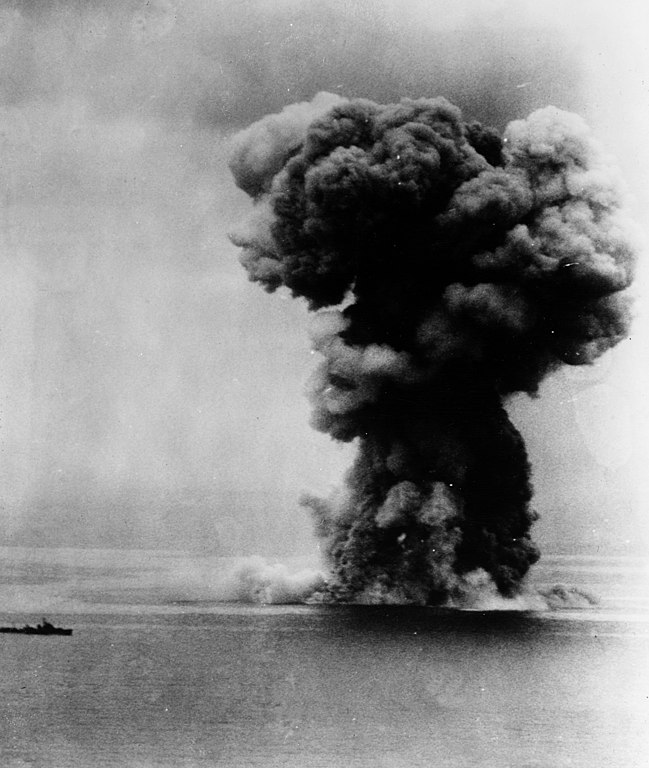
Yamato’s explosion
The story of the Wreck discovery is amazing as well. There was an expedition to the East China Sea in 1982 but the wrecks found kept their muystery. A second expedition was led in 1984 taking photos and videos, later confirmed by designer Shigeru Makino. This allowed to establish her last resting place, 290 kilometres (180 mi) southwest of Kyushu, just under 340 m (1,120 ft) of water, and in two main pieces. Her bow section was measuring about two thirds of the ship. On 16 July 2015, Some Japanese Liberal Democratic Party lawmakers studied the feasibility of raising her as she did not sank very deep. At least they hopes recovering remains of crewmembers and find answers about the exact causes and scenario of the sinking. In May 2016, the wreck was survey digitally, confirming identification and resolving some assumptions. The video and artefacts are ow exposed at the Yamato Museum in Kure, as well as a giant model of the battleship, 1/10 scale.
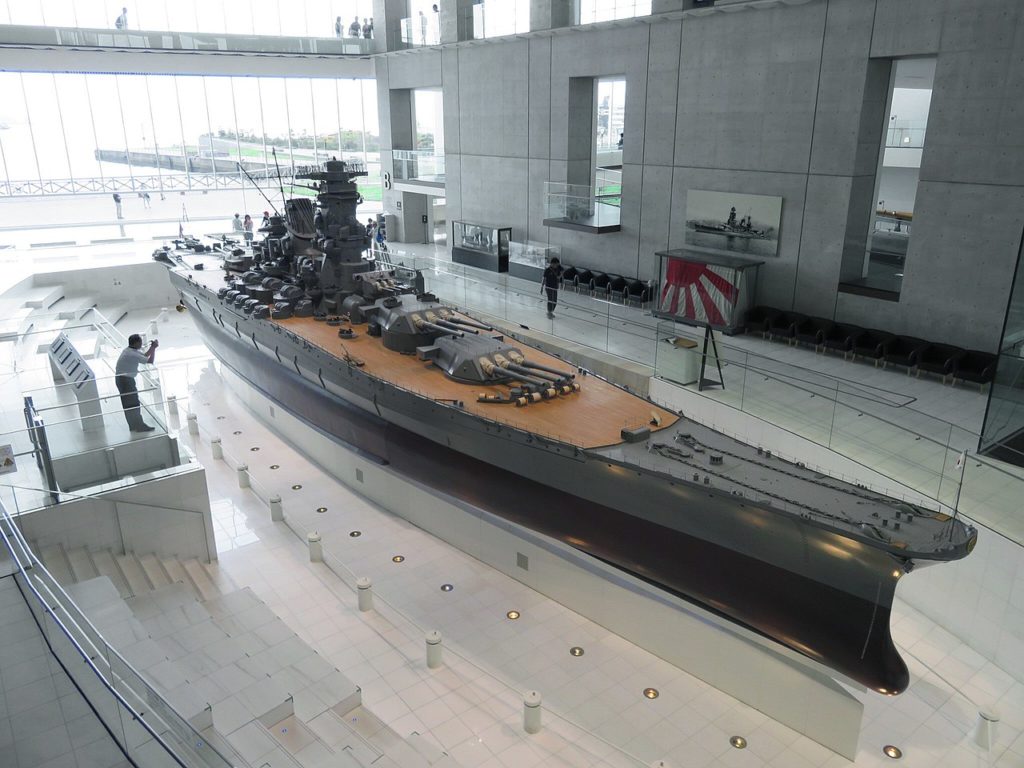
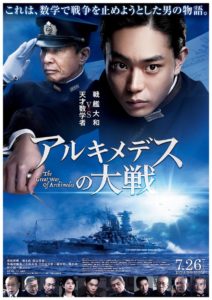 The 1:10 scale model at the Yamato Museum. The museum opened in 2005, also covering many aspects of the maritime history of post Meiji-era Japan. The Yamato made its mark in Japanese popular culture after the war, first in April 1968, with a memorial tower was erected at Cape Inutabu on Tokunoshima, and Leiji Matsumoto 1970’s new television “Space Battleship Yamato” which ran until 2017 and was Japan’s space opera. Yamato became a symbol of heroism and pride after the defeat. In 2005, Toei released a 143-minute movie about the battleship based on a book by Jun Henmi, commemorating the 60th anniversary of the end of the war, and merchandising proved very popular afterwards, notably from Tamiya. The film was a commercial success with 5.11 billion yen at the local box office and clips are wildly popular as well on Youtube (like shown here). Another move was dedicated to the Yamato more recently, “Archimedes no Taisen” (アルキメデスの大戦, or the “Great War of Archimedes” based on engineer Norifusa Mita over internal disputes within the Japanese Navy between those who wanted aircraft carriers or a new battleship and expose some reasons of the sinking of Yamato.
The 1:10 scale model at the Yamato Museum. The museum opened in 2005, also covering many aspects of the maritime history of post Meiji-era Japan. The Yamato made its mark in Japanese popular culture after the war, first in April 1968, with a memorial tower was erected at Cape Inutabu on Tokunoshima, and Leiji Matsumoto 1970’s new television “Space Battleship Yamato” which ran until 2017 and was Japan’s space opera. Yamato became a symbol of heroism and pride after the defeat. In 2005, Toei released a 143-minute movie about the battleship based on a book by Jun Henmi, commemorating the 60th anniversary of the end of the war, and merchandising proved very popular afterwards, notably from Tamiya. The film was a commercial success with 5.11 billion yen at the local box office and clips are wildly popular as well on Youtube (like shown here). Another move was dedicated to the Yamato more recently, “Archimedes no Taisen” (アルキメデスの大戦, or the “Great War of Archimedes” based on engineer Norifusa Mita over internal disputes within the Japanese Navy between those who wanted aircraft carriers or a new battleship and expose some reasons of the sinking of Yamato.
IJN Musashi (5.8.1942 – 24.1.1944)
The career of IJN Musashi (named after the namesake province) was relatively similar to her sister ship as they operated togethe, at least until the battle of the Philippine sea where she was sunk. Musashi was commissioned at Nagasaki on 5 August 1942. She joined the 1st Battleship Division with Yamato, Nagato, and Mutsu. Five days later she made sea trials near Hashirajima and from 3–28 September 1942 she was docked Kure to received her AA armament and her Type 21 radar. Trials and fixes went on until the end of 1942 while her captain Arima was promoted rear admiral on 1 November 1942.
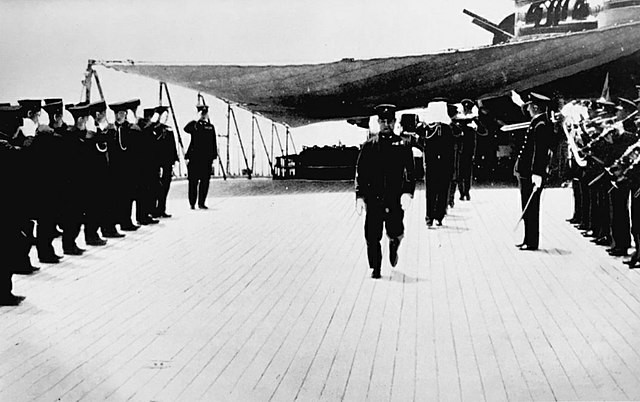
Ceremony onboard Musashi, where the cremated remains of Yamamoto were transferred for a proper burial.
Early Operations
Aassigned to the Combined Fleet headed by Admiral Isoroku Yamamoto, on 15 January 1943, she was sent to bolster the fleet at Truk. In February, she relieved Yamato as flagship and on 3 April, Yamamoto flew to Rabaul in New Britain to direct “Operation I-Go” while he was intercepted by Lockheed P-38 Lightning fighters (Operation Vengeance). His cremated remains were later placed in the cabin he occupied on board Musashi. On 17 May 1943, she was mobilized to intervene when Attu Island was attacked. She sailed alone, but escorted by the carrier Hiyō and two heavy cruisers, plus nine destroyers. She arrived in the northern Pacific archipelago to find no trace of American forces and returned to to Kure. Musashi’s task force were reinforced but not sent before the island was captured. On 9 June 1943, Arima was replaced by Captain Keizō Komura and on the 24 she was overhauled at Yokosuka Naval Arsenal and visited by Emperor Hirohito. Until 8 July, she received two Type 22 radars and sailed for Truk on 30 July, posted as fleet flagship (bearing the mark of Admiral Mineichi Koga). In mid-October 1943 Musashi departed wth the Truk fleet in order to catch the Americans believed to raid Wake Island but failed to make contact. Like Yamato she was soon called “Hotel Musashi”, staying idle until the end of 1943 in Truk. Captain Bunji Asakura took command in November.
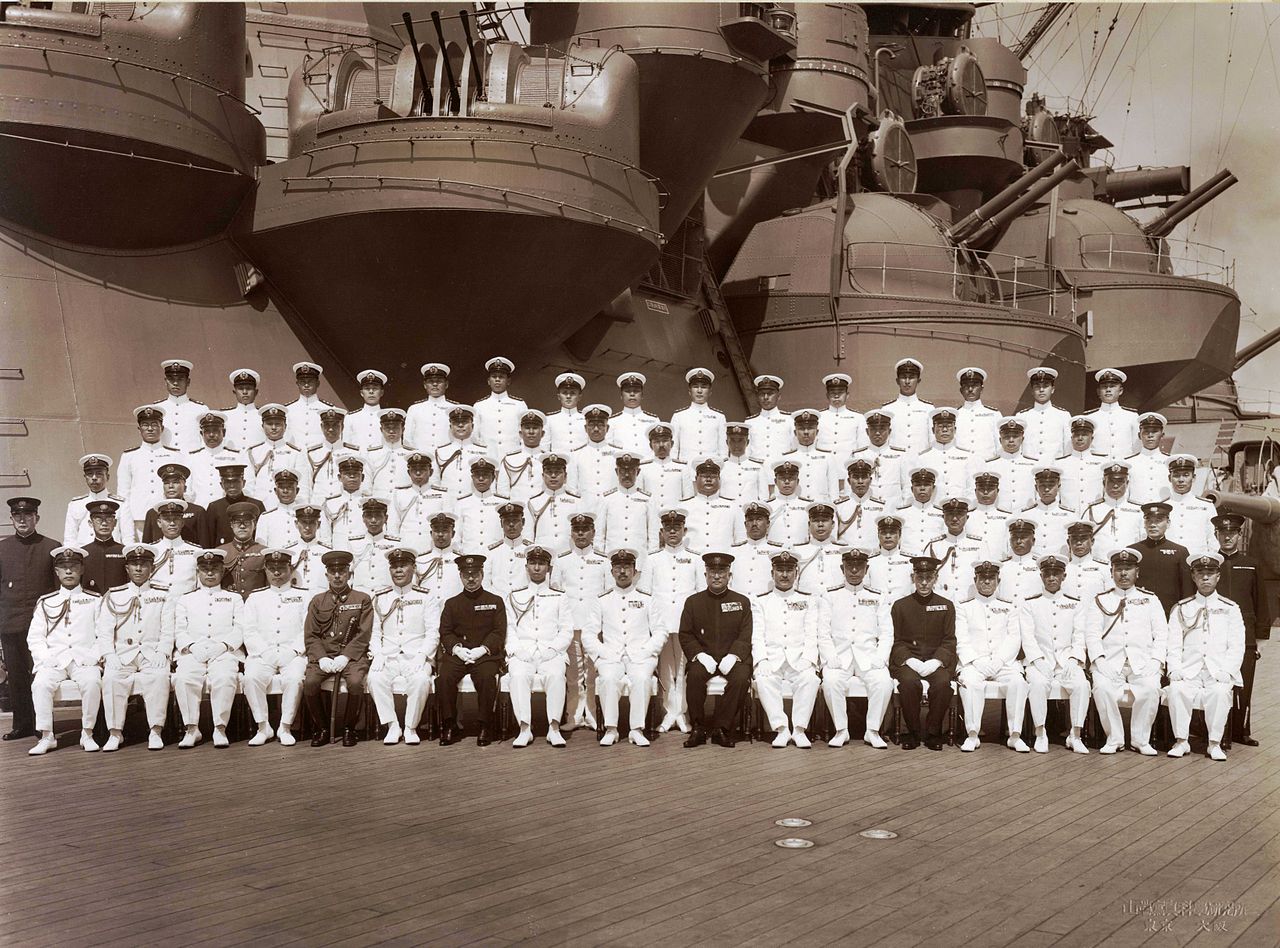
High-ranking officers and Emperor Hirohito (seated center in an admiral uniform) and staff on board Musashi, 24 June 1943
On 10 February 1944, Musashi left Truk for Yokosuka and later sailed for Palau, carrying a fully equipped Imperial Japanese Army battalion and Special Naval Landing Forces. A Typhoon thrown ovrboard most of her equipment but she landed her troops safely on 29 February. On 29 March she sailed by night to head for Truk when she was ambushed by the submarine USS Tunny. She fired six torpedoes, the sixth one hitting near the bow. The flooding was about 3000 tonnes of seawater but she was temporary repaired and sailed for Kure, arriving on 3 April and repaired until 22 April, while her AA armament was upgraded and massively increased. On 22 April she left the drydock with a revised armament, comprising now twenty-four 5-in DP guns, and 130 25 mm guns plus four 13.2 mm machine guns, new radars and even depth-charge rails installed on her fantail. By May 1944, she left Kure for Okinawa, stopping at Tawi-Tawi and assigned to the 1st Mobile Fleet (Vice Admiral Jisaburō Ozawa), teaming with Yamato. On 10 Jun they sailed for Batjan under command of Vice Admiral Matome Ugaki, prepared for Operation Kon, aimed at Biak but it was cancelled and the fleet redirected to Saipan in the Mariana Islands. Now under Vice Admiral Takeo Kurita’s 2nd Fleet both ships were fighting at the Battle of the Philippine Sea. Musashi was escaped inscaved of this massive battle, mostly pitting air forces on both sides, and she headed back to Japan. On 8 July, Musashi embarked 3,522 men and equipment (106th Infantry Regiment, 49th Infantry Division), landed in 17 July at Lingga Island.
Battle of Leyte Gulf
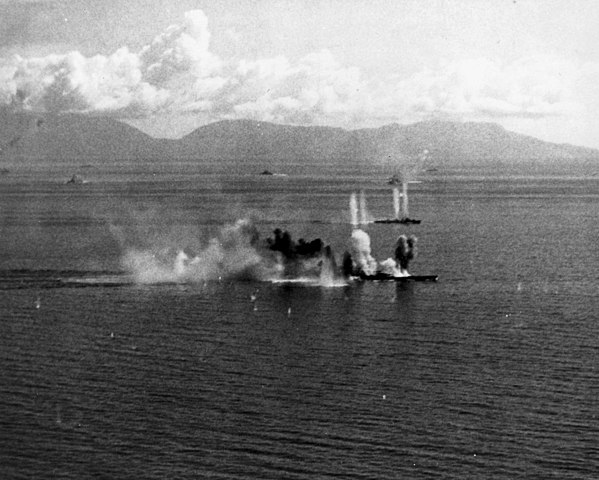
Captain Toshihira Inoguchi took command of Musashi on 12 August 1944. Musashi sailed for Brunei Bay in Borneo, joining the rest of the fleet prepared for “Operation Sho-1”, aimed at the American landings at Leyte. We will not dwelve in detail about the titanic battle staged on several days, but focus on the fate of Musashi.
Musashi recupared the saved cremwen from the sunken Maya a day before, and on 24 October, while she was on the Sibuyan Sea, Kurita’s fleet was spotted by a reconnaissance aircraft from USS Intrepid. Two hours later at 10:27 eight Curtiss SB2C Helldiver dive bombers fell on the Musashi. She was struck by a single 500-pound (230 kg) bomb just on the roof of Turret No. 1, which resisted the impact. This tells volume about the level of protection of the ship. Two minutes later however, IJN Musashi was hi at starboard, amidship, by a torpedo and took 3,000 long tons seawater, 5.5-degree list compensated by counterflooding. She also claimed two Avengers shot down. But around 11:50 eight Helldivers dive bombers, also from USS Intrepid hit her upper deck (failing to detonate), port side of the deck, penetrating two decks and exploding above one engine room. Shrapnels destroyed one steam pipe and two boiler room were shut, power was lost for the port inboard propeller shaft. Speed fell to 22 knots while the crews claimed two Helldivers. Close to 12:00 nine Avengers attacked from both sides and hit her with three torpedoes on her port side. The hydraulic machinery room failed and main turrets switched for auxiliary hydraulic pumps, and flooded yet another engine room, compensated by more counterflooding. Musashi fired her sanshikidan AA shells but apparently one of these shells detonated in the middle gun chamber, Turret No. 1, disabling the elevation mechanism.
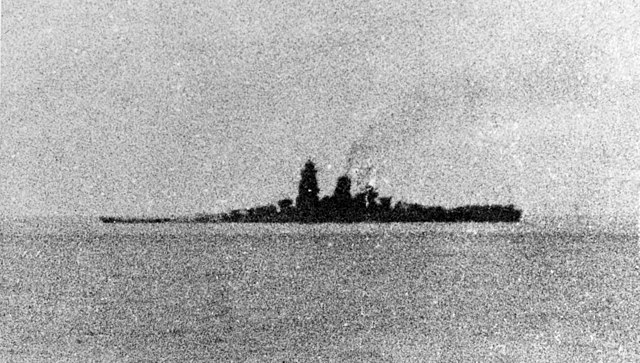
Musashi down by the bow after the air attacks, shortly before her sinking
Her ordeal was not over yet: At 13:31, Musashi faced a wave of 29 aircraft from Essex and Lexington. Two Hellcat fighters strafed her deck while Helldivers took positions, plunged and hit four times, near her forward turrets.Meawnhile Avangers launched four more torpedoes which it forward of Turret No. 1. Although Musashi was listing one degree to starboard only, her freeboard was practically at water level, her bow emerging about 13 feet (4.0 m) above the waves. Speed was still 20 knots (37 km/h; 23 mph) amazingly, but her fate was sealed. For two hours, new waves appeared, first nine Helldivers from USS Enterprise using (450 kg) armour-piercing bombs. Four hit the ship, as well as three more torpedoes. Her starboard bow was ripped apart, leaving more seawater to pour in this time faster, and her speed flee to 13 knots. At 15:25 she faced another wave of 37 aircraft from USS Intrepid, refuelled and rearmed. USS Franklin and USS Cabot also joined the fray and launched their air groups. Musashi was hit by no less than 13 bombs and 11 more torpedoes, her crew claiming three Avengers and three Helldivers. By then she was almost suberged to the deck level, at 6 knots, main steering knocked out, rudder jammed 15 degrees to port and ideas of counterflooding to reduce her list to six degrees appeared superfluitous by now. There was little hope she can made it anywhere, as she had been struck by an estimated 19 torpedoes and 17 bombs.
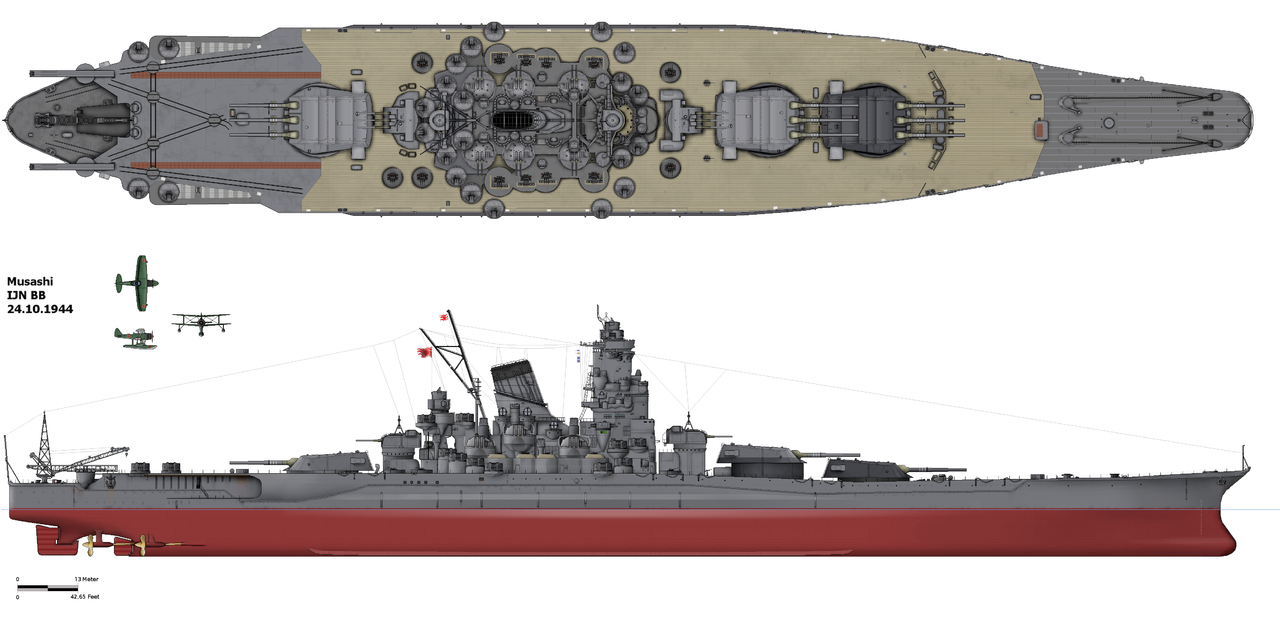
IJN Musashi in 1944, at the time she was lost.
Admiral Kurita left the crippled ship at 15:30. As her rudder was repaired, Musashi limped northwards still listing 10 degrees to port, her bow underwater and forecastle splashed hihgh up by incoming waves. She was now practically a submarine, David’s style. She was escorted by a cruiser and two destroyers while the safety teams worked around the clock with pumps to try a new counter flooding, but eventually her remaining engines stopped, far from any beach. At 19:15 she listed 12 degrees and order came to prepared to abandon ship, taking place 15 minutes later. IJN Musashi capsized at 19:36. But contrary to her sister ship, she sanl deep, at 4,430 feet (1,350 m) on a precise location, her captain Inoguchi going down with her. She had more suvivors than Yamato, 1,376 of her 2,399 strong crew. To mask the loss to the public back in Japan, half of these survivors were thrown in the defence of the Philippines.
In 2006-2008 there were plans from General Dominador Resos (President, Romblon Cultural Heritage Association, Inc.) to Commemorate the Battle of Sibuyan Sea, but also locating the remains of Musashi and even making plans of refloating her. However the discovery of scattered remains but not her wreck scattered these plans in 2015. A plaque and ceremony were held but shipwreck hunters was able to locate the wreck. Microsoft co-founder Paul Allen found her however after eight years of searching, announcing it in March 2015. She sunk in one piece but exploded underwater. A movie was made of the expedition. Due to her status of war grave, the National Museum of the Philippines eventually secured the wreckage’s integrity by law, as an archaeological site.
About the last sister ships: Shinano and N°111 (1944)
IJN Shinano
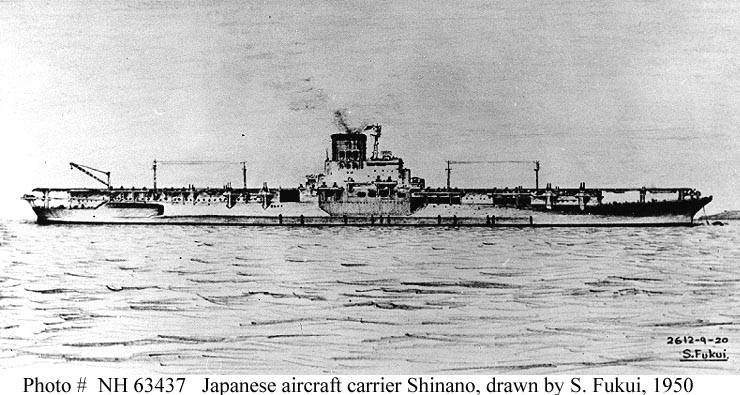
IJN Shinano, drawing by by S. Fukui (Naval Historical Center # NH 63437)
IJN Shinano was the last laid down, in Yokosuka in May 1940, and her unnamed sister-ship N°111 (prospective name Kii) in Kure, 7.11.1940. They were revised in design, as construction of their earlier sisters was advanced and notably their protection was slightly lighter while the AA artillery was bolstered.
Design specifics
The second pair were based on the same A-140F6 design variant but incorporated improvements born during the long construction process of the Yamato and Musashi. Construction methods were simplified to urg completion, while increased flagship facilities were integrated. Engineers also found a way to store additional fuel, for longer cruising ranges. As 1939-40 operation n the West showed how dedaly magnetic mines coild be, engineers revised the bottom protection.
-Reinforced bottom protection (triple layer of plating of 1 inch (25,4 mm) thick each but a third layer of only 0.5 inches down to 2 layers in more restricted space, all proof against a 300kg TNT mine.
-Added weight compensated by 10 mm thinner main belt plates and deck plates alsl ddown of 10 mm (190 mm) plus 540mm barbettes (20 mm less).
-Extra protection proposed for the 15,5cm turrets
-Possible extension of the conning tower, as well as the flag bridge/flagship setup.
-Fuel storage revised
-100mm/60cal Type 98 DP guns incorporated in exhange of the old 12,7cm/40.
Construction was suspended in December 1941 as the war started, to be finally cancelled in early 1942. Indeed, the initial naval plan set to be completed in 1950 was now no longer relevant and materials and workforce were needed elsewhere. About June 1942 with the news of the defeat at Midway, IJN Shinano’s hull was about 50% complete. Rather to convert her as initially planned as a battleship, it was found more judicious to replace recent losses with a new carrier, one in addition tht can boast the most serious armour ever seen on an aircraft carrier. Design compromises had to be made, and design work commenced.
The third ship of the class was originally scheduled for completion in April 1945. Construction was speed up after the defeat at the Battle of the Philippine Sea in June 1944 and was revised again but missed her completion deadline in October 1944 due to the lack of manpower and resources. This resulted in a botched completion, and poor workmanship until she was launched on 8 October 1944. Captain Toshio Abe took command. Her pre-career started badly as she was damaged during the floating-out procedure, as caissons in the dock were not properly ballasted with seawater. This delayed her completion to 26 October. Her next commissioning was followed by a first and only mission in which she departed Yokosuka at 18:00 on 28 November without escort, and 2,175 officers and men onboard and still 300 shipyard workers and 40 civilian employees working on her. Watertight doors and hatches were left open for them to continue working more effectively. these openings included some manholes in the double and triple-bottomed hull, which all contributed to the disaster.
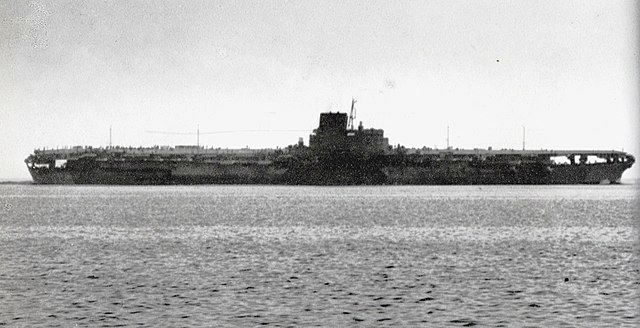
We will not dwelve in it as the Shinano will have its own dedicated chapter later in 2021. Commander Abe decided to act in daylight passage, allowing extra time to train his crew, which ended in a rushed nighttime run when he learned there was no air support available. IJN by then Shinano carried six Shinyo suicide boats and 50 Ohka suicide flying bombs and was scheduled to join Kure to complete fitting out and deliver her payload in the Philippines and Okinawa. But at 20:48, the US submarine Archerfish (Commander Joseph F. Enright) picked her on her radar and started a parallel course, waiting an opportunity. 1h50 later, Shinano detected in turn the submarine’s radar, and she was the zig-zagging below 20 knots with her destroyer escort. At 02:56 on 29 November, Shinano was turned southwest and turned south about 10 minutes later, exposing her side to USS Archerfish, which fired six torpedoes and start diving to 400 feet. Four struck Shinano. Besides structural failures and intense flooding, ruptured oil tank, failure of pumps and all openings to allow the workers to operate, the flooding could not contained. At first it was judged manageable and the crew confident enough, to take their time to take measures. Abe was also overconfident and ordered keeping maximum speed which pushed even more seawater inside the hull and in few minutes the was 10 degrees starboard and counting. Pumps could not do much and Abe rectified the course to beach the ship, only increasing the listt to 15 degrees by 03:30. At 06:00 her list was 20 degrees and her engines stopped, and later orered gradual evacuation by the destroyers. She lost all power around 09:00 and order was given to abandon ship as she listed 30 degrees until finally capsizing at 10:57, stern-first, carrying to the bottom 1,435 officers, ratings and civilians.
IJN Kii (Warship Number 111)& N°797
The hull of N°111 in Kure Naval yard basin was about 30% complete when construction was suspended and later cancelled. It was decided to dismantle her in order to recuperate the much-needed stell for other priorities of wartime production. N°797 was also proposed in the 1942, 5th supplementary program, and cancelled before ordering it to any yard. N°798 and 799 were also proposed, with a revised design of six 20 inches guns (520 mm) as planned back in 1935, fitted with 18-in armour, but they were also cancelled in 1942 about the same time.
The additional battleships were mainly motivated by the US response, order of the new Montana class. They were to incorporate further enhancements (Kai-No.110) base don the Shinano design.
Notably it was to comprise a reinforced bottom protection, full triple bottom under magazines and machinery at all places, possibly increased plates thickness. The ASW torpedo defense was also revised with additional longitudinal holding bulkheads, at the bow and stern, just to limit flooding and extra bulkheads on the citadel. The AA battery was modenrized with new directors and AA platform installed on the main superstructure, and a bridge with an expanded flagship facility.
Conclusion
All three ships had fairly short career, Musashi of less than two years and Shinano did not even made it to full completion (…) and only yamato managed three years of rather dull service, with long inactivity in Truk, Borneo or Kure. Her only real occasion came at Samar, where a scared admiral decided to retire her from a rather unequal fight. Instead of battleships, she would fire on planes with a largely experimental shell, sort of last-ditch defense. Both Yamato and Musashi could do little against the onslaught of the US Navy air groups. No AA (and IJN AA defense was not particularly good compared to USN AA defense) could protect them from a storm or bomb and torpedo hits, no armour thickness could withstand such punishment. We can only guess how they would fare if Halsey had launhed his battleships against the fleet rather than being convinced to send aviation instead to intercept them underway. An end which was far away from the minds of engineers and officers that designed them, as the ultimate superiority battleships. It proved the world the age of the battleships beasts started in 1859 as ‘ironclads’ was to end for good. They dominated the oceans for about 80 years.
The Epic end of IJN Yamato – Extract from “the great war of archimedes”: The dawn of battleship age
Read More/Src
https://weaponsandwarfare.com/2020/01/14/yamato-1941-part-i/
Books:
Chesneau, Roger, ed. (1980). Conway’s All the World’s Fighting Ships 1922–1946.
Gardiner, Robert; Gray, Randal, eds. (1985). Conway’s All the World’s Fighting Ships, 1906–1921.
Evans, David C.; Peattie, Mark R. (1997). Kaigun: Strategy, Tactics, and Technology 1887–1941.
Fitzsimons, Bernard, ed. (1977). The Illustrated Encyclopedia of 20th Century Weapons and Warfare.
Friedman, Norman (1985). U.S. Battleships: An Illustrated Design History.
Garzke, William H.; Dulin, Robert O. (1985). Battleships: Axis and Neutral Battleships in World War II.
Jackson, Robert (2000). The World’s Great Battleships. London: Brown Books.
Jentschura, Hansgeorg; Jung, Dieter; Mickel, Peter (1977). Warships of the Imperial Japanese Navy, 1869–1945.
Johnston, Ian; McAuley, Rob (2000). The Battleships. Osceola, Wisconsin: MBI Pub. Co.
Lengerer, Hans; Ahlberg, Lars (2014). Capital Ships of the Imperial Japanese Navy 1868-1945: The Yamato Class and Subsequent Planning.
Preston, Anthony (1999). The World’s Great Aircraft Carriers: From World War I to the Present.
Reynolds, Clark G. (1968). The Fast Carriers: The Forging of an Air Navy. New York: McGraw-Hill.
Schom, Alan (2004). The Eagle and the Rising Sun: The Japanese-American War, 1941–1943, Pearl Harbor through Guadalcanal
Skulski, Janusz (1989). The Battleship Yamato. Annapolis, Maryland: Naval Institute Press.
Steinberg, Rafael (1980). Return to the Philippines. New York: Time-Life Books.
Stille, Mark (2008). Imperial Japanese Navy Battleship 1941–1945. Oxford: Osprey Publishing.
Wheeler, Keith (1980). War Under the Pacific. New York: Time-Life Books.
Willmott, HP (1999). The Second World War in the Far East. London: Cassell & Co.
Yoshida, Mitsuru; Minear, Richard H. (1999) [1985]. Requiem for Battleship Yamato.
Yoshimura, Akira (2008). Battleship Musashi: The Making and Sinking of the World’s Biggest Battleship. Tokyo: Kodansha International.
Naval Weapons of World War Two” by John Campbell
Battleships: Axis and Neutral Battleships in World War II” by W.H. Garzke, Jr. and R.O. Dulin, Jr.
“Japanese Cruisers of the Pacific War” by Eric Lacroix and Linton Wells II
“The Yamato Class and Subsequent Planning” by Hans Lengerer and Lars Ahlberg
Videos and Films extracts
1/10 Model at the yamato museum
https://www.youtube.com/watch?v=KylITMES4QA
Secrets of the Yamato, documentary about the underwater expedition over Yamato. bbc documentary film.
The Yamato by Drachinfels
https://www.youtube.com/watch?v=BxyK1Z2m5rw
The great war of archimedes (2019)
The yamato in VR
The modeller’s corner
-Tamiya 78025 Japanese Battleship Yamato Model Kit 1/350
-Tamiya waterline series Japanese Battleship Yamato Model Kit 1/700
-Tamiya waterline series Shinano Model Kit 1/700
-Fujimi 1/500 IJN Yamato Class Battleship
-Yamato Type 94 46cm Gun Main Turret No.1- Takom 1:72
-Hasegawa Yamato 1/450
-Japanese Navy Battleship Musashi Nichimo 1:500
-Yamato Final Upgrade Set (Normal Edition) 1/700 Pit-Road
-Yamato UPC 1:400 1964
-IJN Battleship Musashi/Yamato Minicraft Hasegawa 1:450
-Yamato – Revell 1:1200


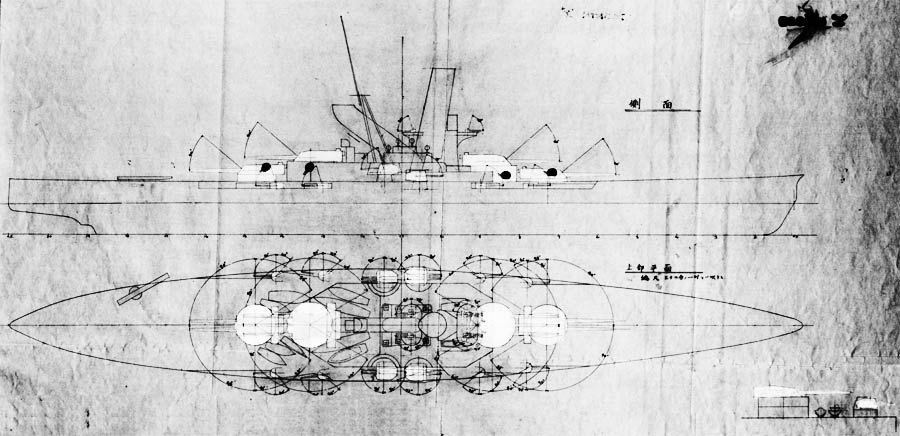
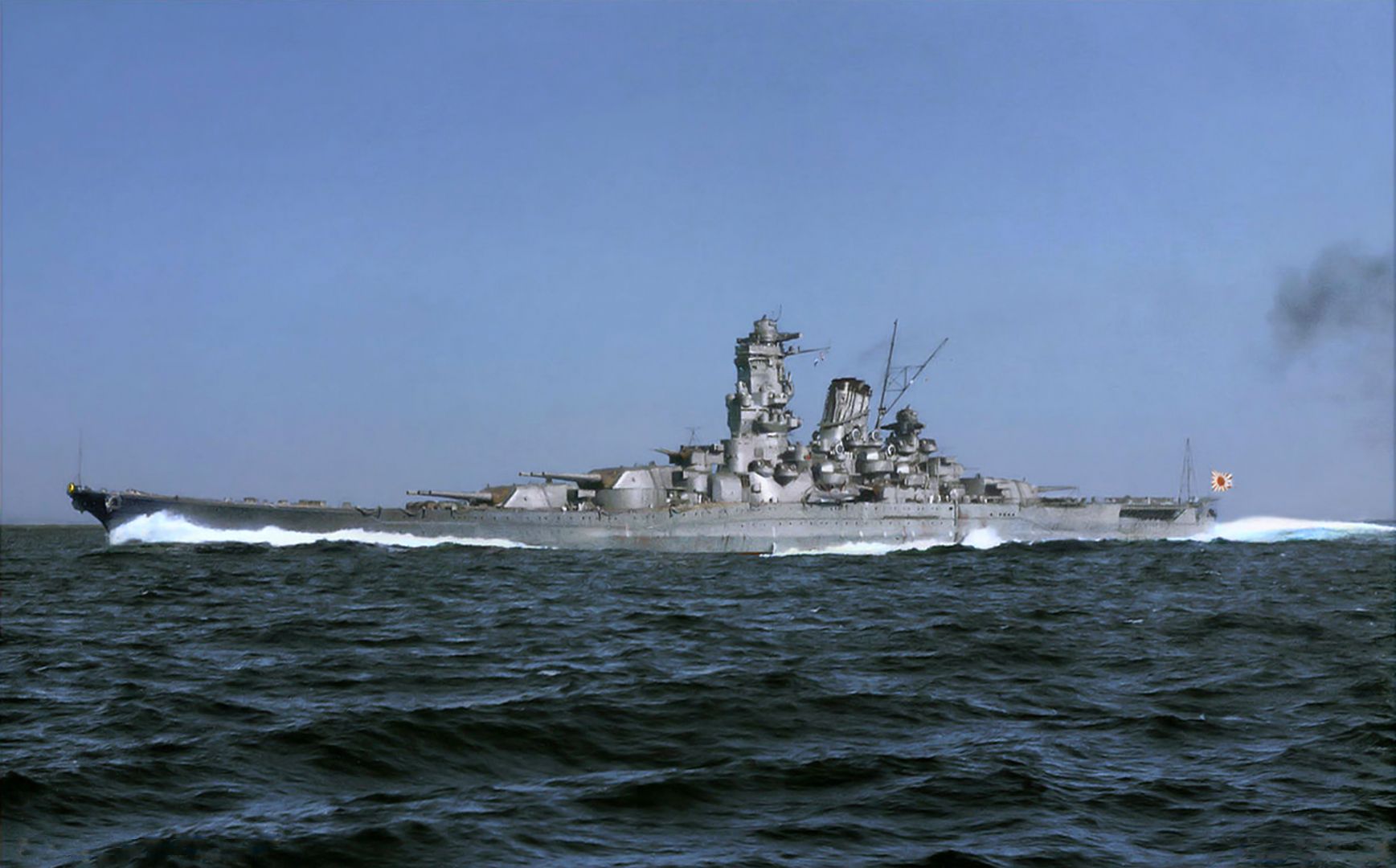
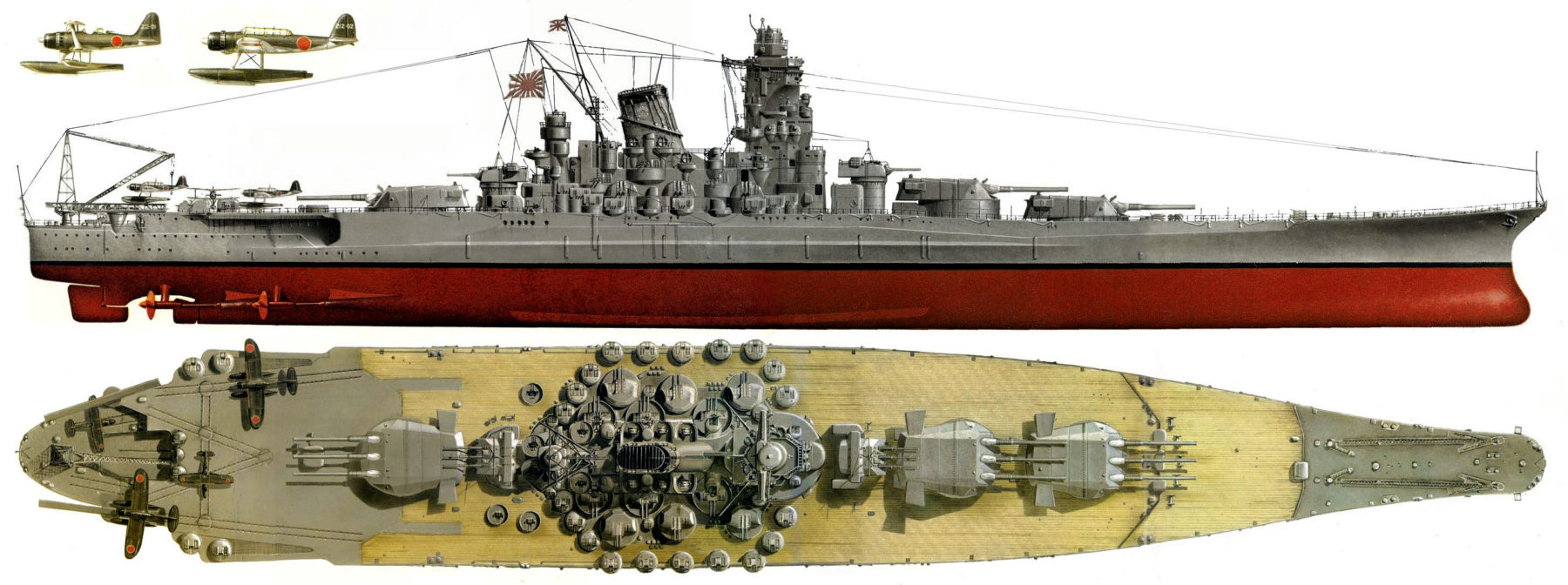
 Latest Facebook Entry -
Latest Facebook Entry -  X(Tweeter) Naval Encyclopedia's deck archive
X(Tweeter) Naval Encyclopedia's deck archive Instagram (@navalencyc)
Instagram (@navalencyc)





 French Navy
French Navy Royal Navy
Royal Navy Russian Navy
Russian Navy Armada Espanola
Armada Espanola Austrian Navy
Austrian Navy K.u.K. Kriegsmarine
K.u.K. Kriegsmarine Dansk Marine
Dansk Marine Nautiko Hellenon
Nautiko Hellenon Koninklije Marine 1870
Koninklije Marine 1870 Marinha do Brasil
Marinha do Brasil Osmanlı Donanması
Osmanlı Donanması Marina Do Peru
Marina Do Peru Marinha do Portugal
Marinha do Portugal Regia Marina 1870
Regia Marina 1870 Nihhon Kaigun 1870
Nihhon Kaigun 1870 Preußische Marine 1870
Preußische Marine 1870 Russkiy Flot 1870
Russkiy Flot 1870 Svenska marinen
Svenska marinen Søværnet
Søværnet Union Navy
Union Navy Confederate Navy
Confederate Navy Armada de Argentina
Armada de Argentina Imperial Chinese Navy
Imperial Chinese Navy Marinha do Portugal
Marinha do Portugal Mexico
Mexico Kaiserliche Marine
Kaiserliche Marine 1898 US Navy
1898 US Navy Sovietskiy Flot
Sovietskiy Flot Royal Canadian Navy
Royal Canadian Navy Royal Australian Navy
Royal Australian Navy RNZN Fleet
RNZN Fleet Chinese Navy 1937
Chinese Navy 1937 Kriegsmarine
Kriegsmarine Chilean Navy
Chilean Navy Danish Navy
Danish Navy Finnish Navy
Finnish Navy Hellenic Navy
Hellenic Navy Polish Navy
Polish Navy Romanian Navy
Romanian Navy Turkish Navy
Turkish Navy Royal Yugoslav Navy
Royal Yugoslav Navy Royal Thai Navy
Royal Thai Navy Minor Navies
Minor Navies Albania
Albania Austria
Austria Belgium
Belgium Columbia
Columbia Costa Rica
Costa Rica Cuba
Cuba Czechoslovakia
Czechoslovakia Dominican Republic
Dominican Republic Haiti
Haiti Hungary
Hungary Honduras
Honduras Estonia
Estonia Iceland
Iceland Eire
Eire Equador
Equador Iran
Iran Iraq
Iraq Latvia
Latvia Liberia
Liberia Lithuania
Lithuania Mandchukuo
Mandchukuo Morocco
Morocco Nicaragua
Nicaragua Persia
Persia San Salvador
San Salvador Sarawak
Sarawak Uruguay
Uruguay Venezuela
Venezuela Zanzibar
Zanzibar Warsaw Pact Navies
Warsaw Pact Navies Bulgaria
Bulgaria Hungary
Hungary

 Bundesmarine
Bundesmarine Dutch Navy
Dutch Navy Hellenic Navy
Hellenic Navy Marina Militare
Marina Militare Yugoslav Navy
Yugoslav Navy Chinese Navy
Chinese Navy Indian Navy
Indian Navy Indonesian Navy
Indonesian Navy JMSDF
JMSDF North Korean Navy
North Korean Navy Pakistani Navy
Pakistani Navy Philippines Navy
Philippines Navy ROKN
ROKN Rep. of Singapore Navy
Rep. of Singapore Navy Taiwanese Navy
Taiwanese Navy IDF Navy
IDF Navy Saudi Navy
Saudi Navy Royal New Zealand Navy
Royal New Zealand Navy Egyptian Navy
Egyptian Navy South African Navy
South African Navy






























 Ukrainian Navy
Ukrainian Navy dbodesign
dbodesign
mistake in the wording of many (amny aspects of)
Thanks for spotting ! I’m currently doing a proper re-reading/fixing of the whole article.
Thanks for the information.
A lot of good detailed history.
The pursuit of size with the ‘Yamato’ class reached a point where it was impacting the design of the ships. Deep-draught ships such as the ‘Yamato’ class require deep anchorages and special docks. This reduced the flexibility of deployment, one of the major advantages of warships.